On a sunny Summer day I headed to Rouen, the historic capital of Normandy. For many years I have been eager to discover the ‘City of 100 bell towers’ from the words of Victor Hugo. So I booked a train ticket for a day-trip from Paris and explored the historic city. Prior to my visit I had planned walking in the old town of Rouen with not-to-miss landmarks. Here is the itinerary. I hope you’ll find it useful convincing enough to stop at Rouen too!
Forget the suburbs and reach the old town!
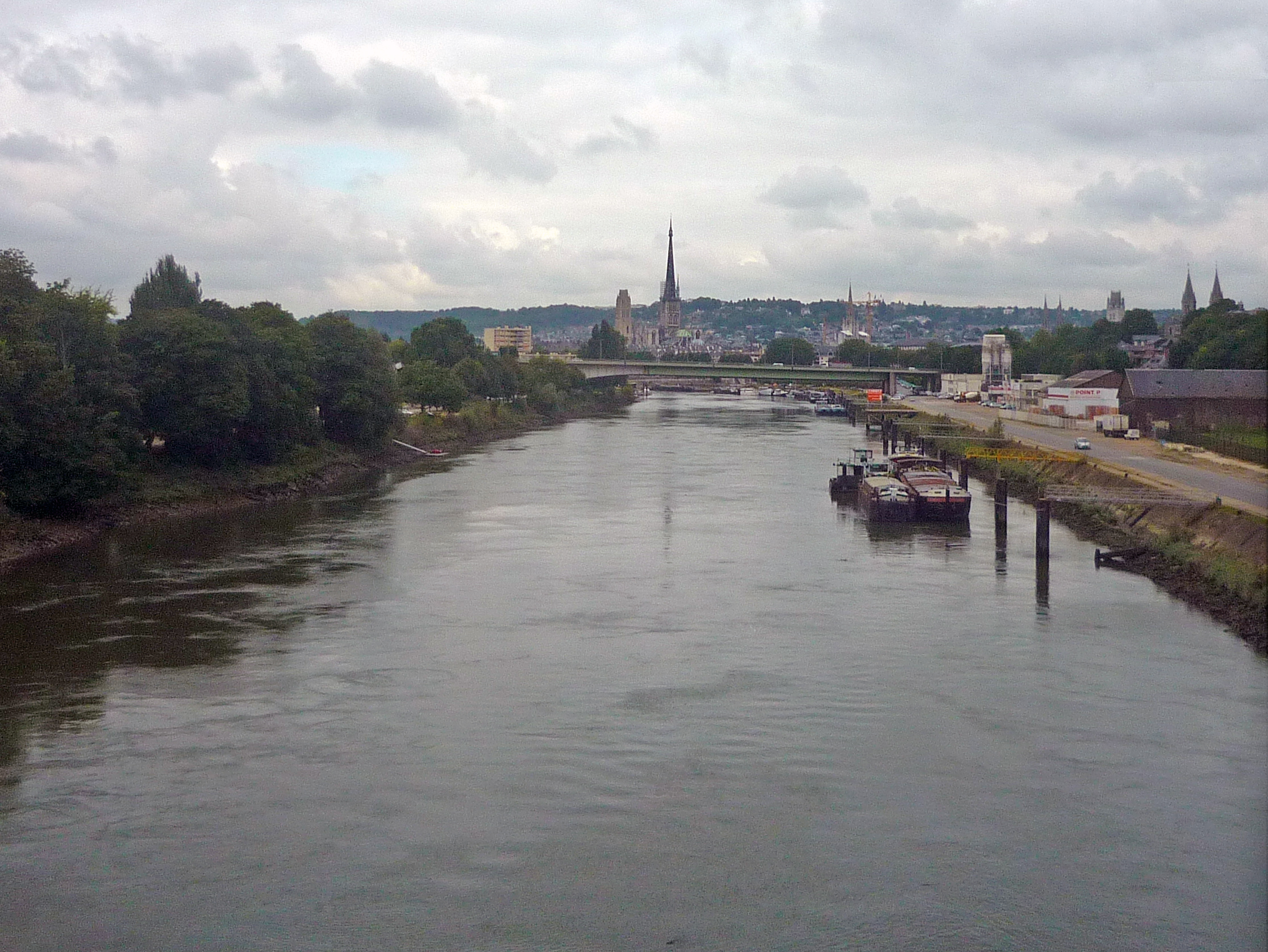
Coming from the direction of Paris or Le Havre, the industrial suburbs of Rouen might not impress you. Don’t worry, for beyond lies the historic city centre, a “must-see” in the region. It would be a shame to miss a stroll through its fascinating heritage that includes Gothic churches and mansions and hundreds of restored half-timbered houses… Since the aftermath of World War Two, the city centre has undergone a costly upmarket restoration of its historical gem, which is largely pedestrianised.
Walking in the Old Town of Rouen
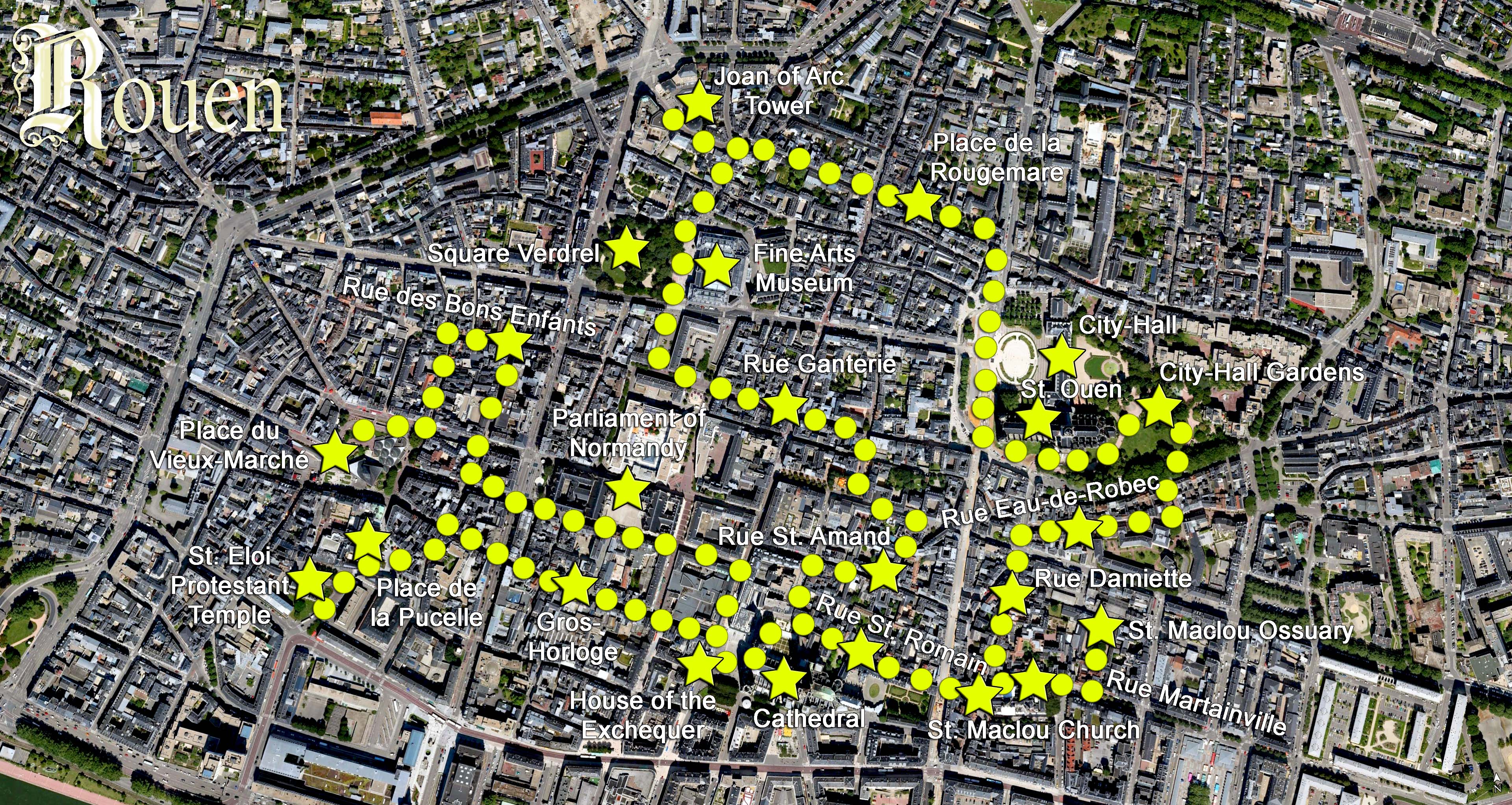
My walk through the main landmarks and monuments of Rouen was 5.5 km long. I made it in one day but to be honest it was quite a race. I stopped too many times to get the photos you’ll see below… and unfortunately had to hurry inside the beautiful churches of the town! If you intent to visit the Clock tower and the Fine Arts museum, I recommend you stay overnight in Rouen.
Where to stay in Rouen?
You can choose from a great range of accommodation in Rouen, from hotels to B&B and campings! My recommendation is to book your accommodation near the city-centre. Although it’s a more pricey option, you’ll save time on transportation and can access most of the landmarks I discovered while walking in the old town of Rouen.
Also, when possible, don’t wait the last minute to book as finding hotel rooms can be a problem, especially on the weekends.
To book your accommodation in Rouen, click on this affiliate link which will redirect you to our partner booking.com… or use the interactive map below:
Alrighty, let’s start walking in the old town of Rouen…
Temple St. Éloi, Place Martin Luther King
The walk starts from the Protestant Temple St. Éloi on Place Martin Luther King (not far from the banks of River Seine).
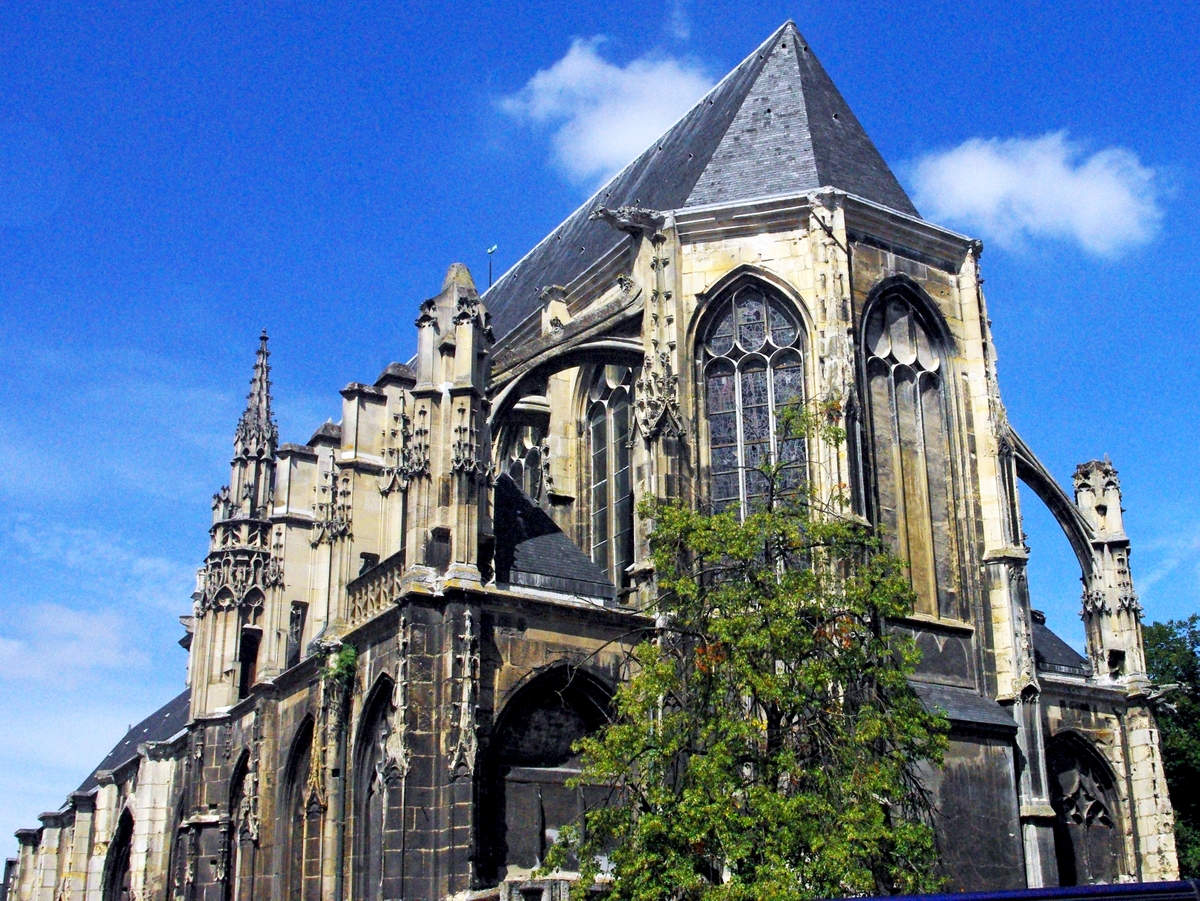
The 16th century church of Saint Éloi became a Protestant place of worship for the Reformed church in 1803.
Reach the adjacent Place de la Pucelle.
Place de la Pucelle and Hôtel de Bourgtheroulde
The name of the square led many to erroneously believe this was the place where Joan of Arc had been burnt at the stake. Actually the maid was killed on the adjacent square of Place du Vieux-Marché.
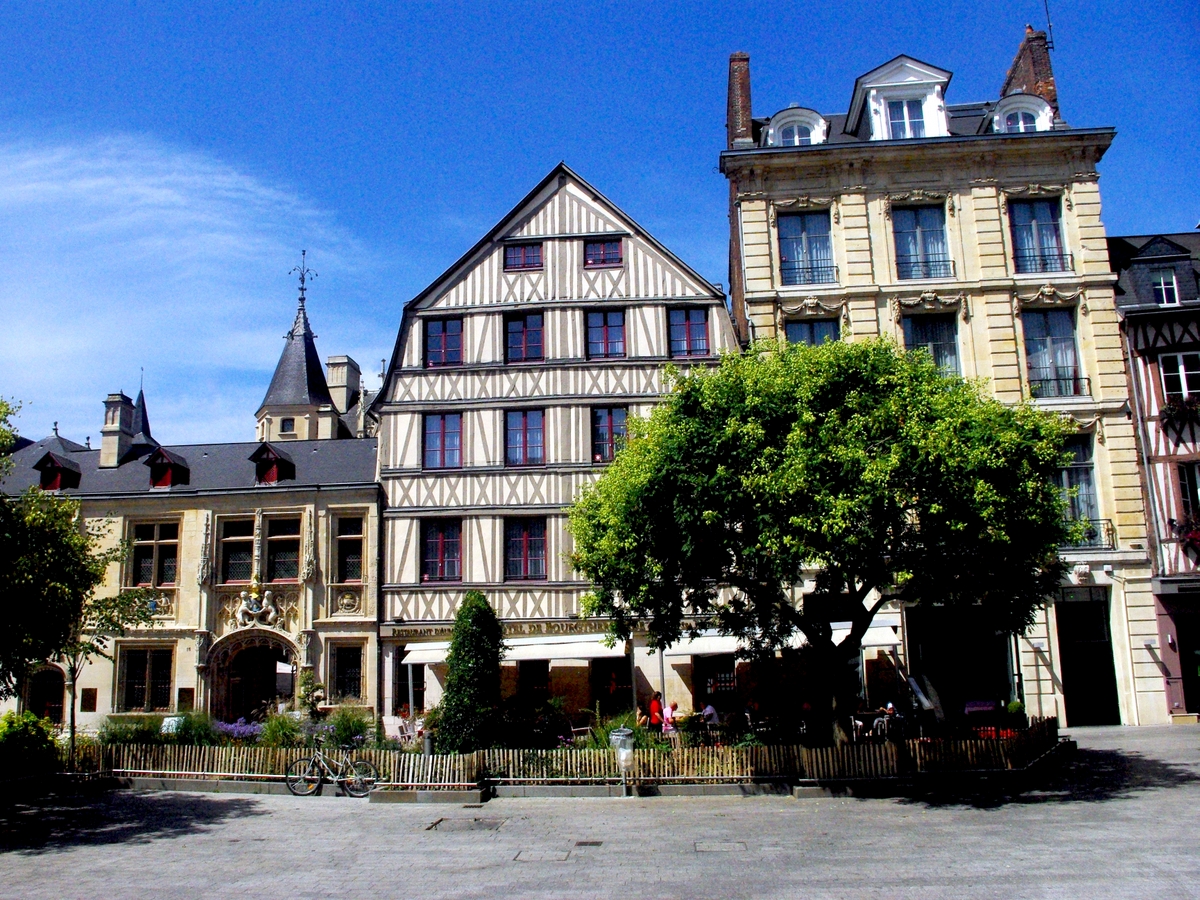
The fine Gothic Bourgtheroulde House (pronounce ‘Bourtroud’) dates from the 16th century. It served as a residence to Guillaume II le Roux, Lord Bourgetheroude and member of the Exchequer of Normandy. Although dominantly Gothic, there are some Renaissance influences visible from the courtyard. After having housed a bank for many years, it became a 5 star hotel in the 2010s.
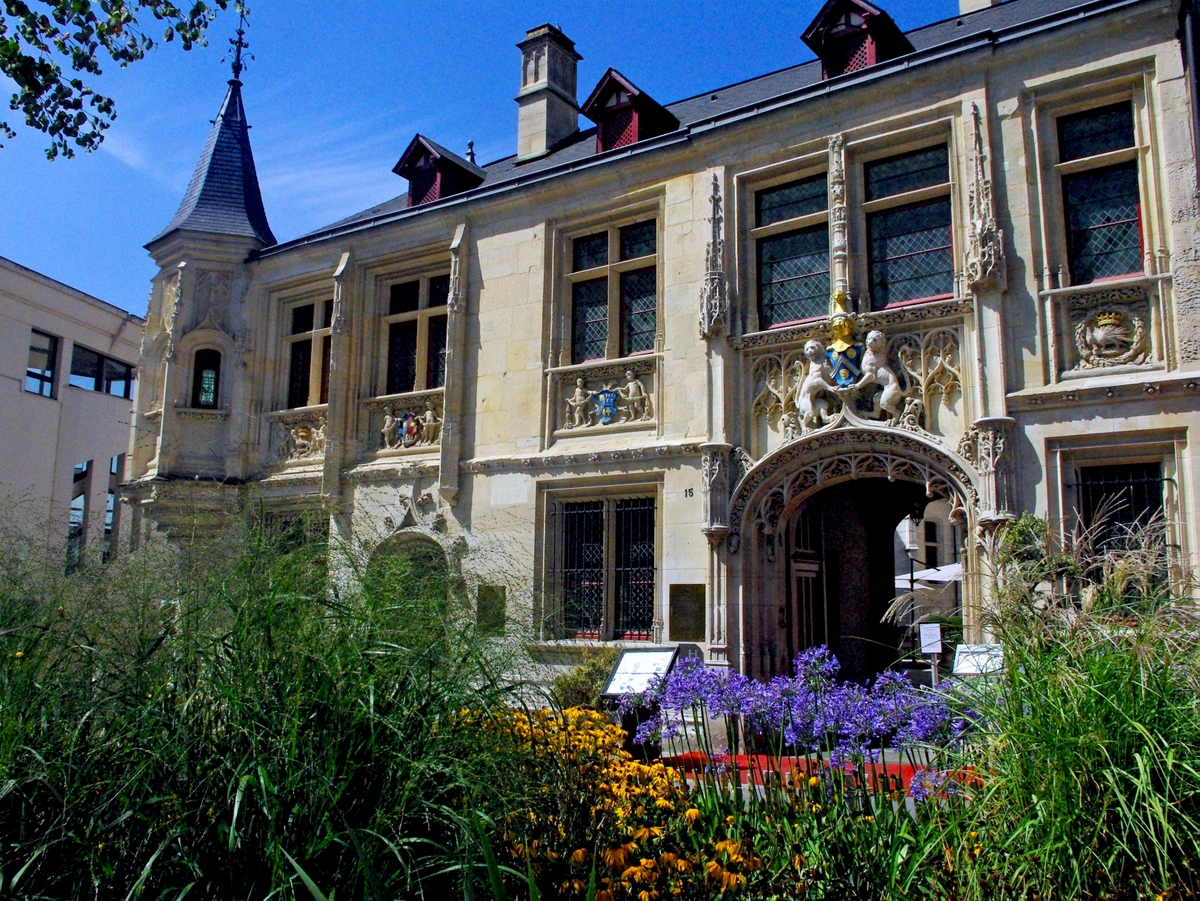
From there, walk on rue de la Vicomté and turn right on Rue du Gros Horloge towards the Cathedral.
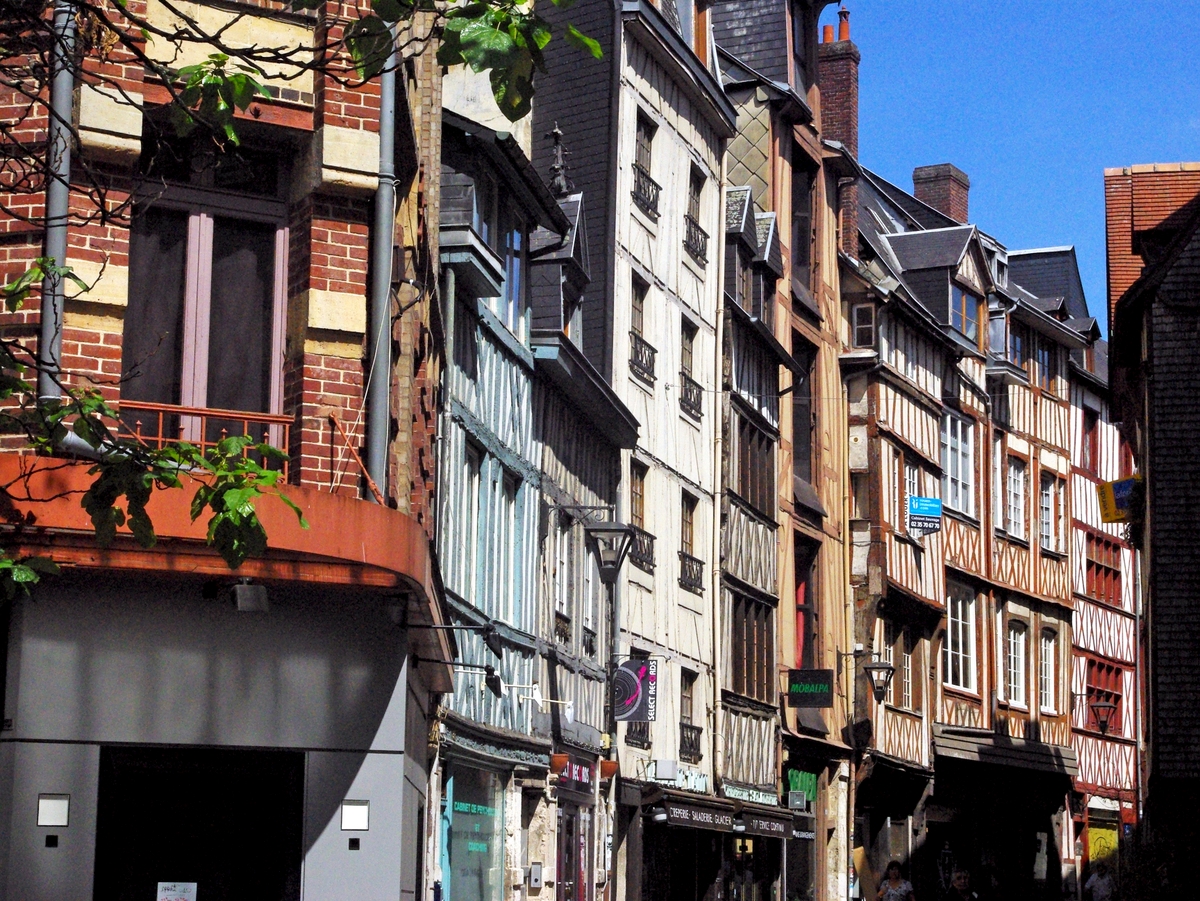
Rue du Gros Horloge
Sometimes called by locals “Rue du Gros”, this 420 metre long street is famous for the astronomical clock (the “Gros Horloge”). Charming half-timbered buildings built on waterproof stone bases border the picturesque cobbled street. Some of them feature richly decorated corbelling made of oak. Some experts date a few of the houses along the Rue du Gros Horloge to before the time of Joan of Arc’s death at the stake in 1431.

The astronomical clock known as Le Gros Horloge is the pride of the Rouen people. It dominates a Renaissance arch which has spanned the historic street since 1527. The clock lies roughly equidistant between the Place du Vieux Marché and the cathedral. The Gros Horloge itself dates back to the 16th century and its movement from 1389. A Gothic belfry flanks the Gros Horloge. It was built between the 14th and the 15th centuries and houses the bells linked to the clock’s movement.
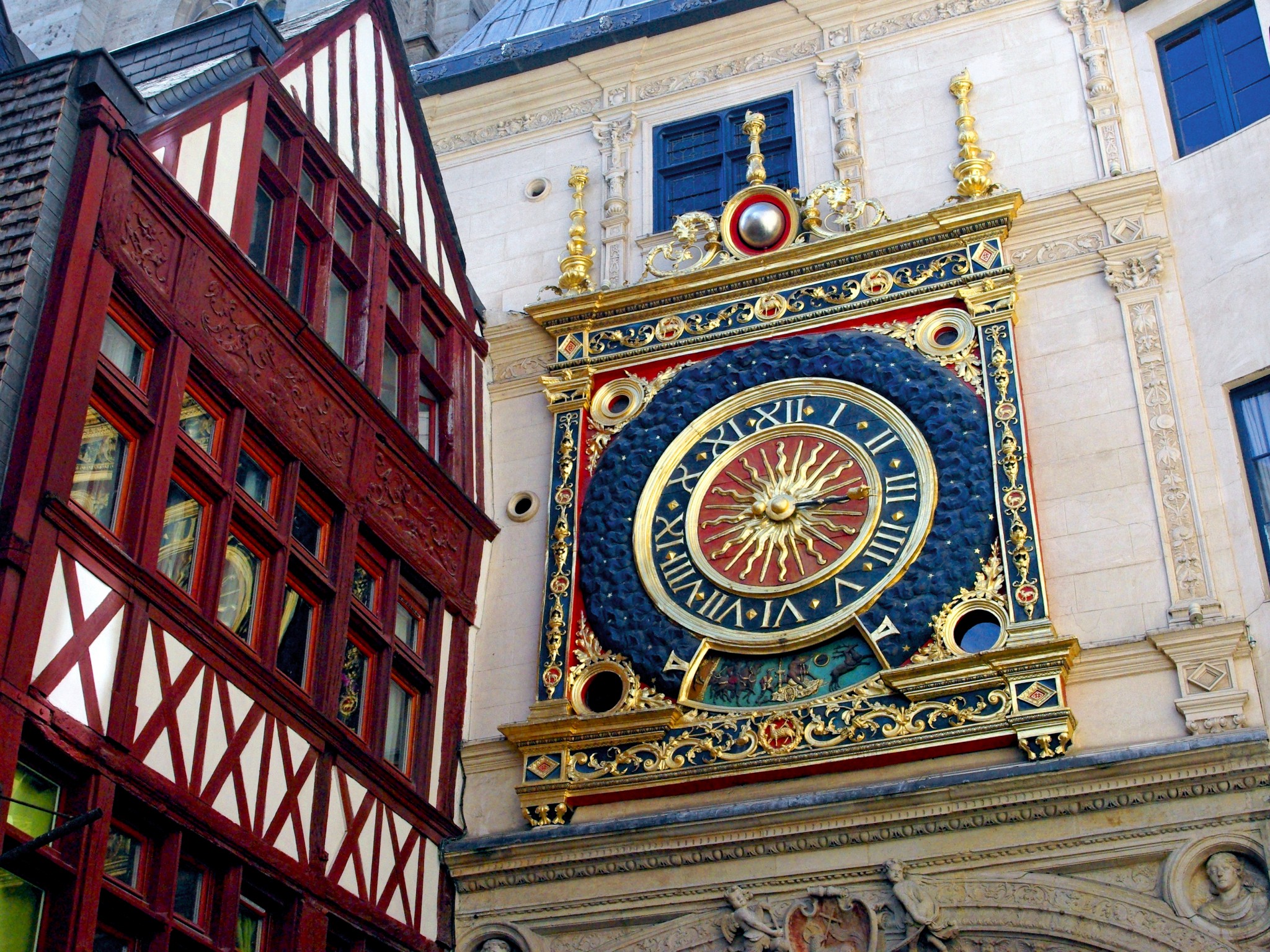
Camille Pissarro painted the Rue du Gros Horloge in 1885.

Rue du Gros-Horloge became the first pedestrian street in France in 1971. Apart from its historic atmosphere, it owes its popularity to the numerous shops and department stores. The view of the cathedral in the distance towering over the half-timbered façades is pretty amazing.
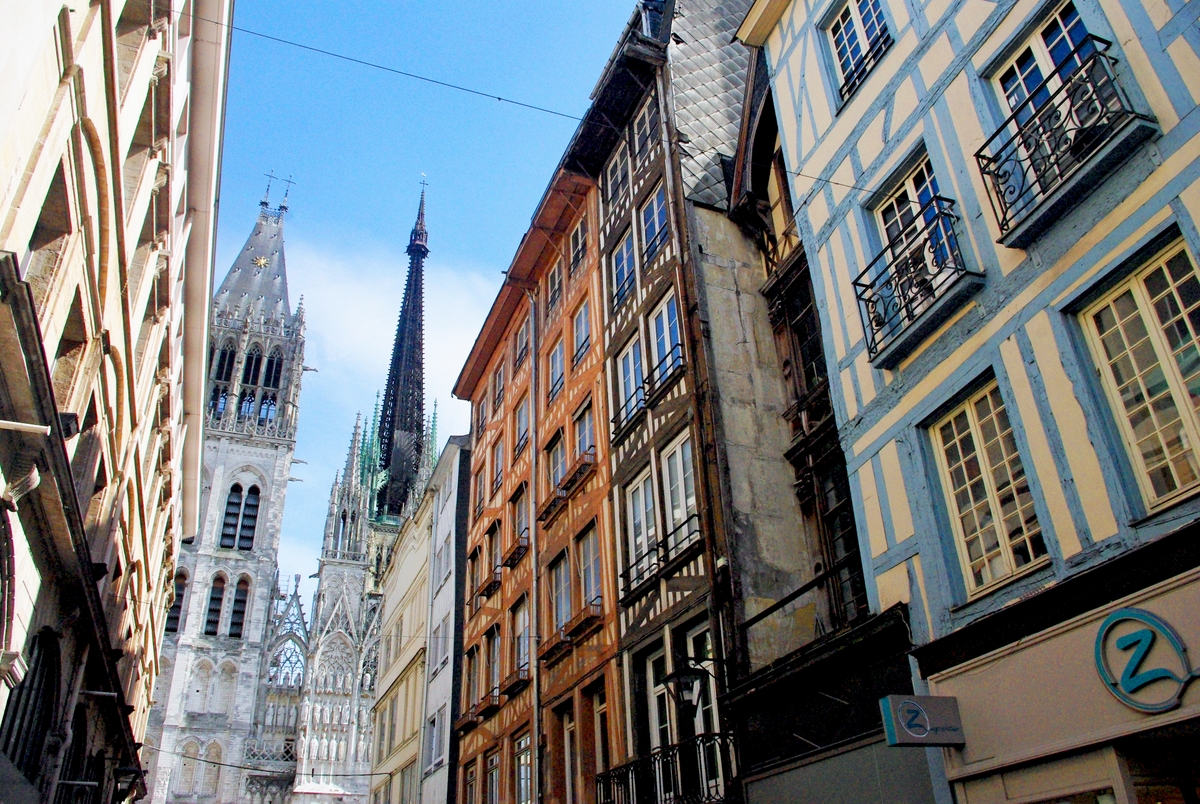
Walk through the end of the pedestrian street to the Place de la Cathédrale. There, you can find Rouen’s Tourist Office Centre and the stunning western façade of Rouen’s cathedral.
Place de la Cathédrale and Rouen Cathedral

Rouen’s most distinctive landmark, seen from far away, is the lofty and imposing cathedral, whose spire stands 151 metres high. From the Place de la Cathédrale, the church appears in all its glory, with its Tour de Beurre (butter tower) to the right and the Tour Saint Romain to the left.
Facing the cathedral, turn to the right and after a few metres, enter the Bureau des finances (House of the Exchequer) where you will find the Tourist Board of Rouen.
House of the Exchequer
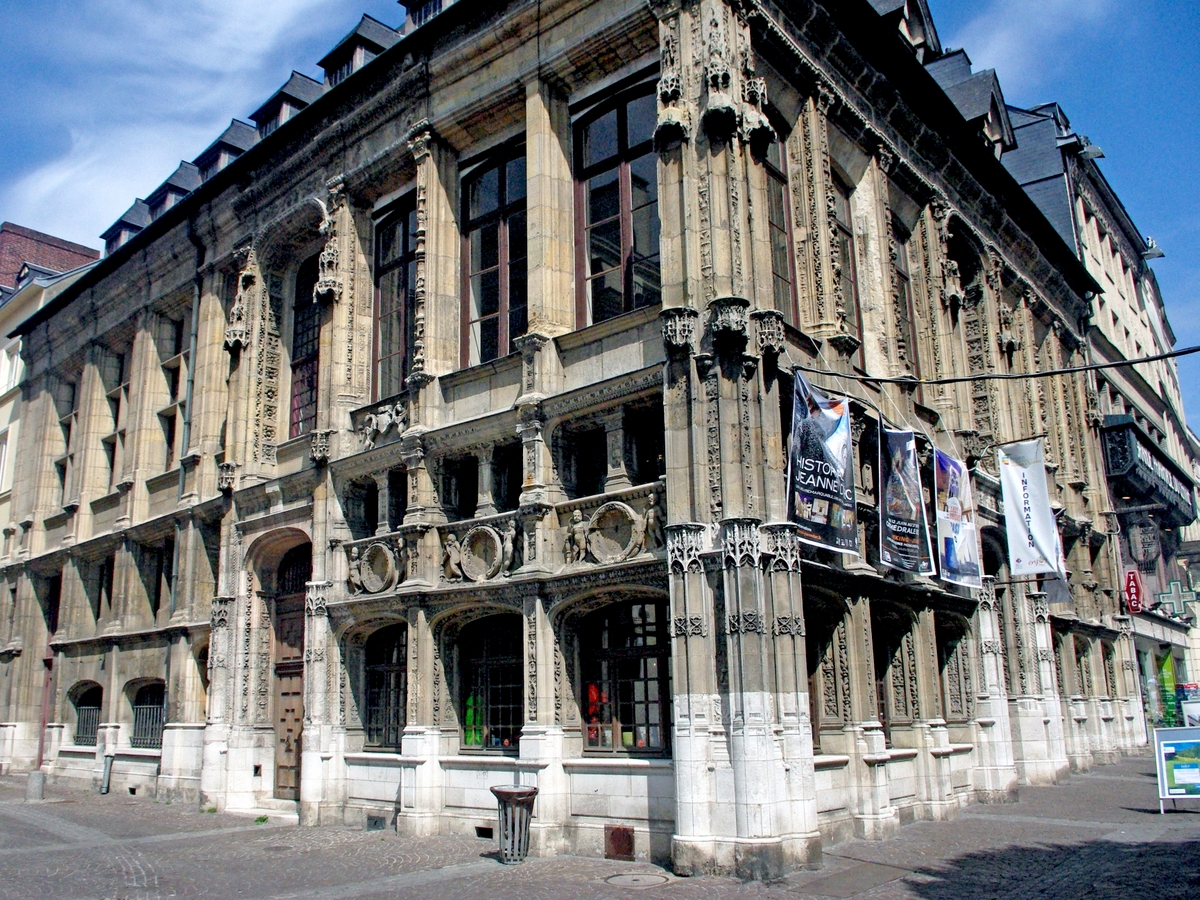
The Bureau des Finances (House of the Exchequer) houses the Tourist Board of Rouen and faces the cathedral’s façade. Built from 1509 to 1540 for the Exchequer General of Normandy, it represents a fine example of Flamboyant Gothic architecture and also features early Renaissance elements.
Walk across the Place de la Cathédrale towards the Tour Saint Romain, then turn right at Rue Georges Lanfry. Continue straight ahead: the street changes its name to Rue Saint Romain.
Rue Saint-Romain
On your right is the “Cour des Libraires” leading to the North Transept of the Cathedral.
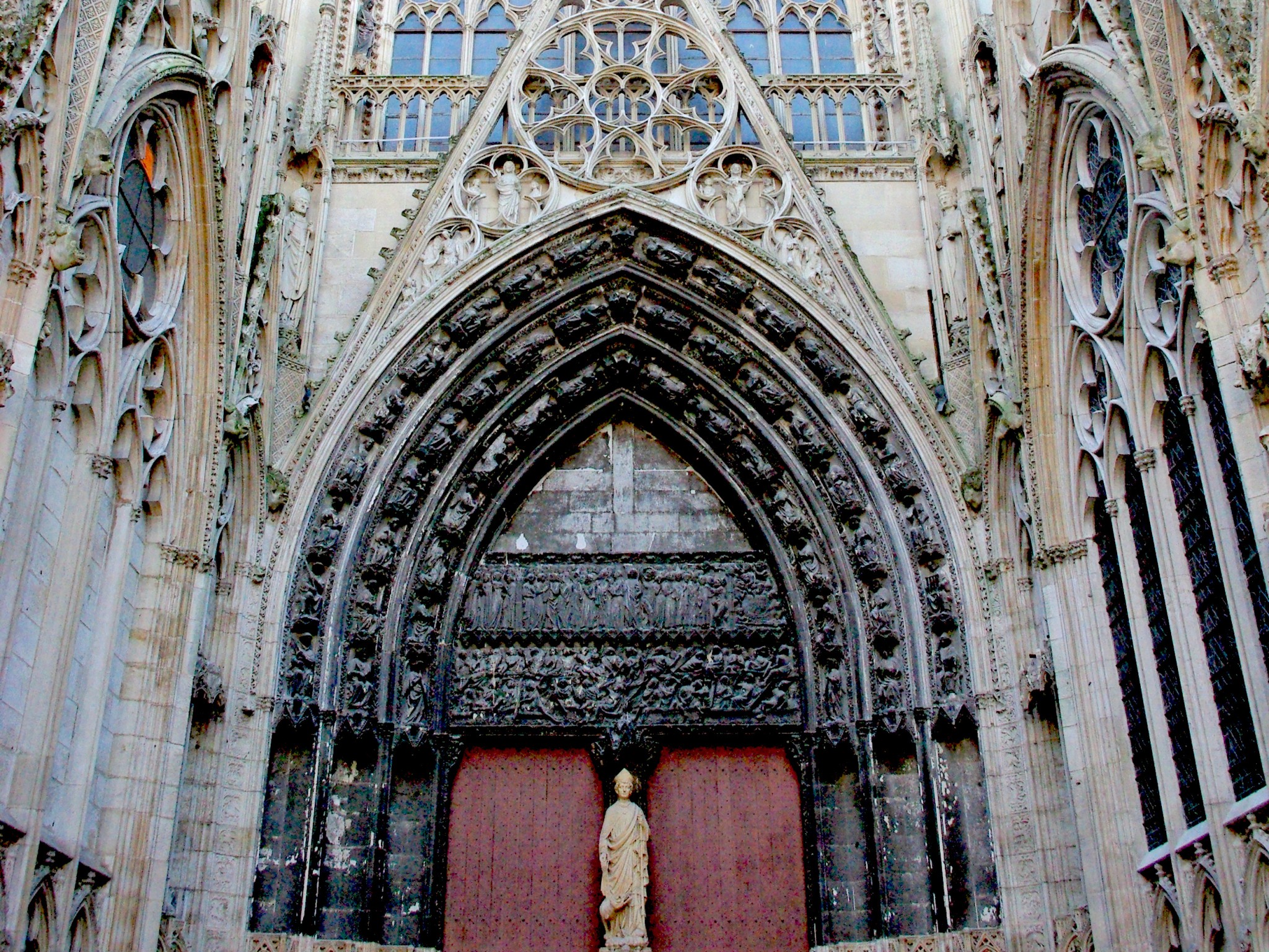
There are many half-timbered houses bordering the north side of the street.
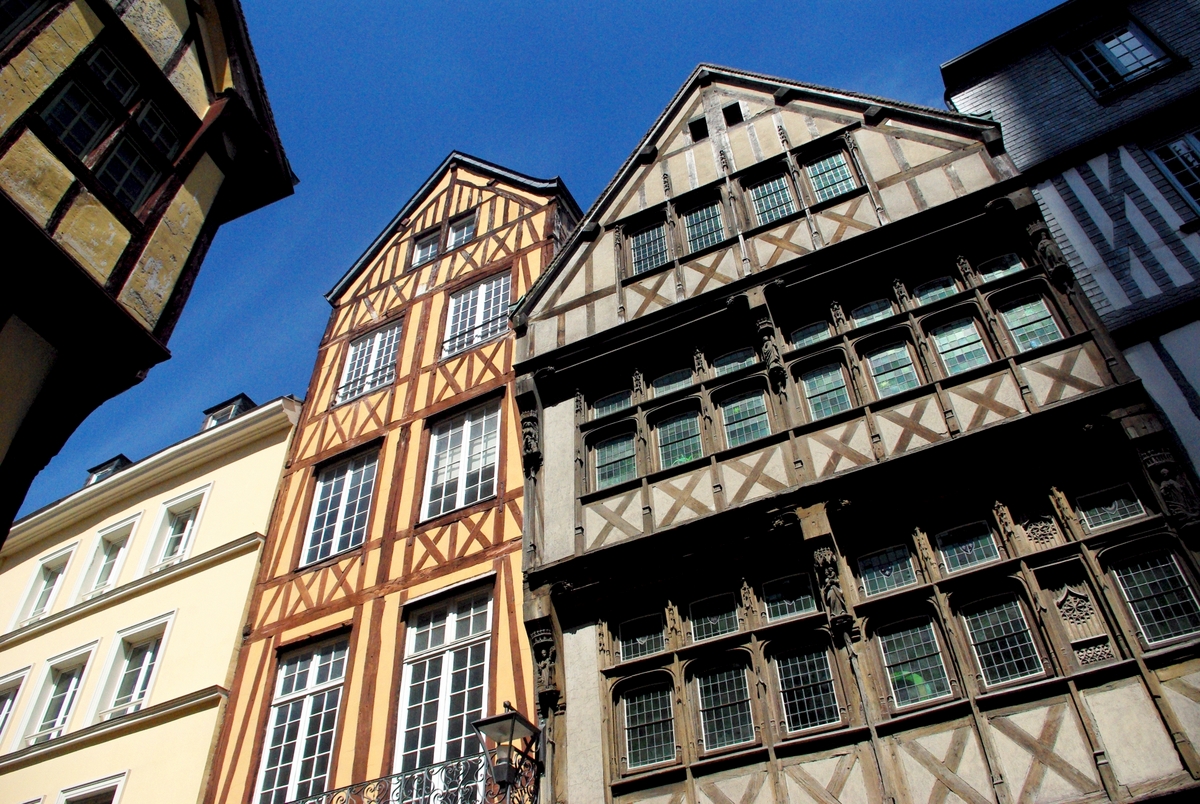
On rue Saint-Romain are the ruins of a former chapel where the trial of Joan of Arc ended on the 29th May 1429. It is there as well that her rehabilitation was proclaimed in 1456.
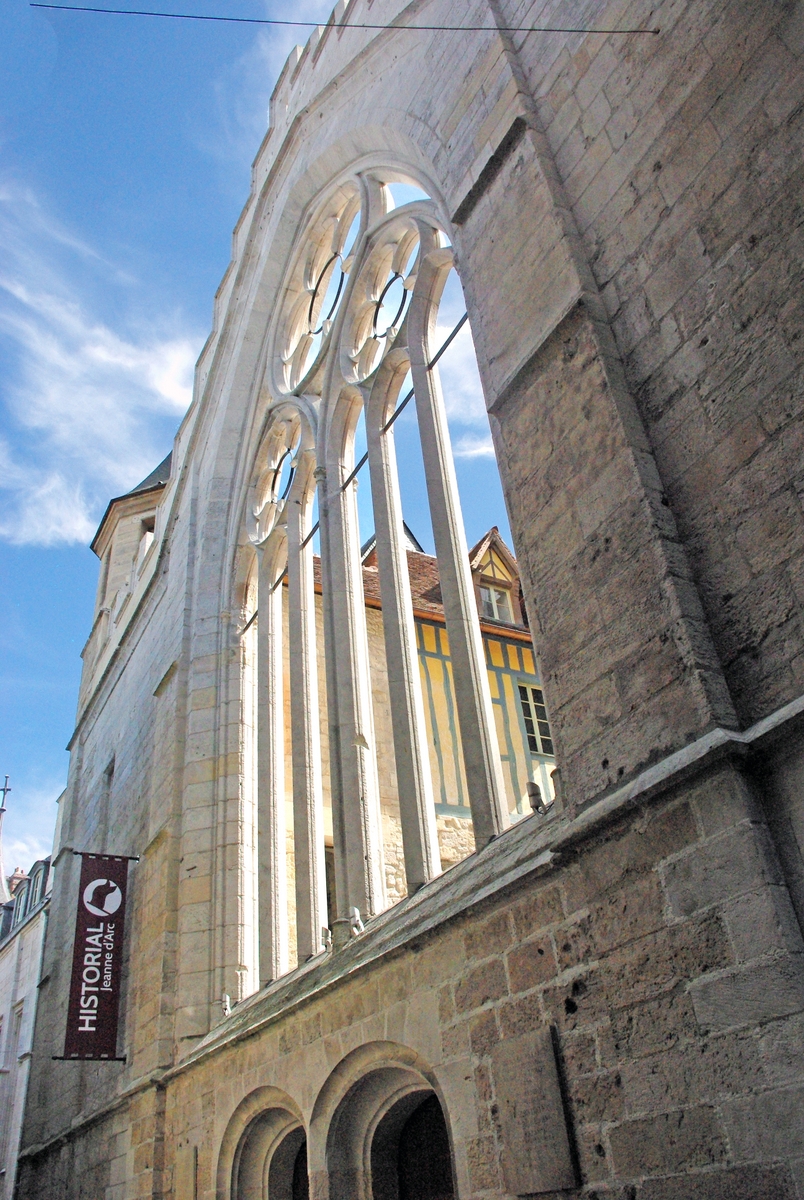
Later on, cross the Rue de la République and you will arrive on the little intimate square of Place Barthélémy towered by the impressive church Saint Maclou. The place Barthélémy owes its name from the 19th century architect who built the church spire. In order to install the spire, architects had several houses destroyed. To the left of the facade, observe the lovely 16th century fountain.
Saint Maclou Church
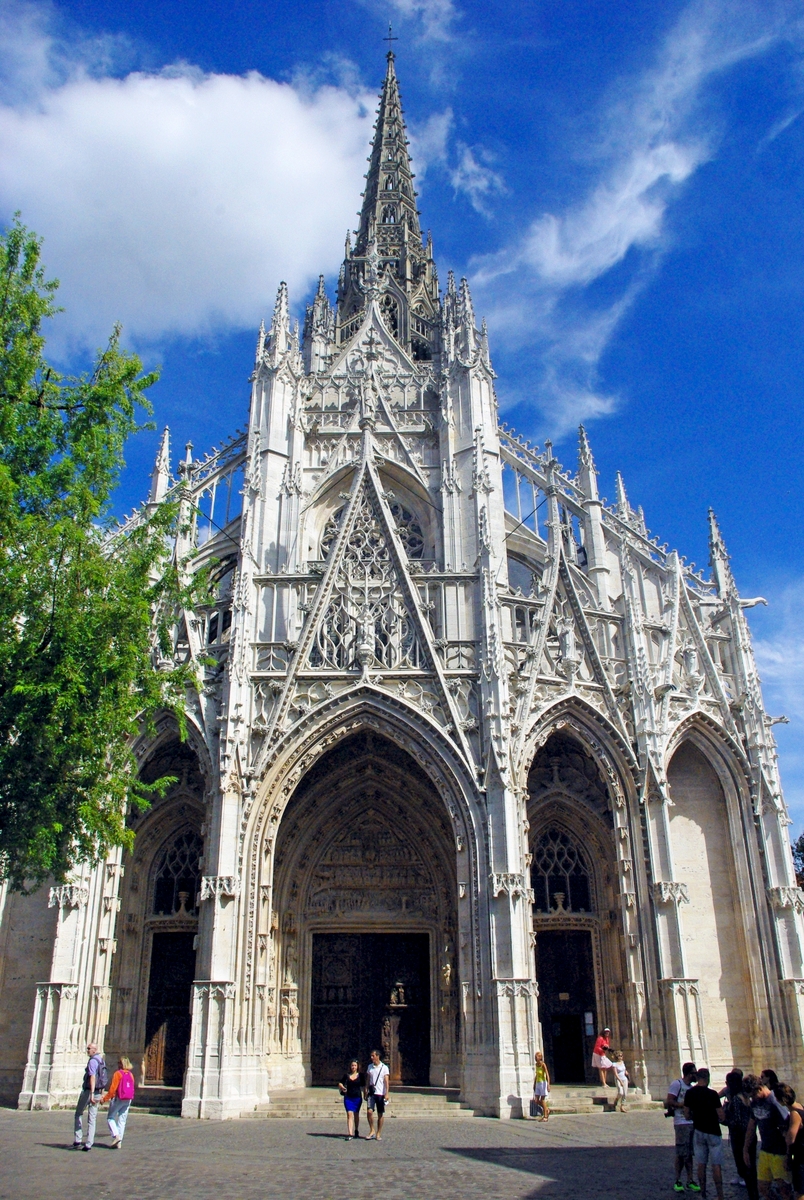
The Church of Saint-Maclou is arguably one of the most striking churches in Rouen. A Flamboyant church dedicated to Saint Malo, it is considered one of the best examples of Gothic architecture in Rouen, alongside with the cathedral and the Church of Saint Ouen. A fine elaborated spire has topped the lantern tower since the 19th century.
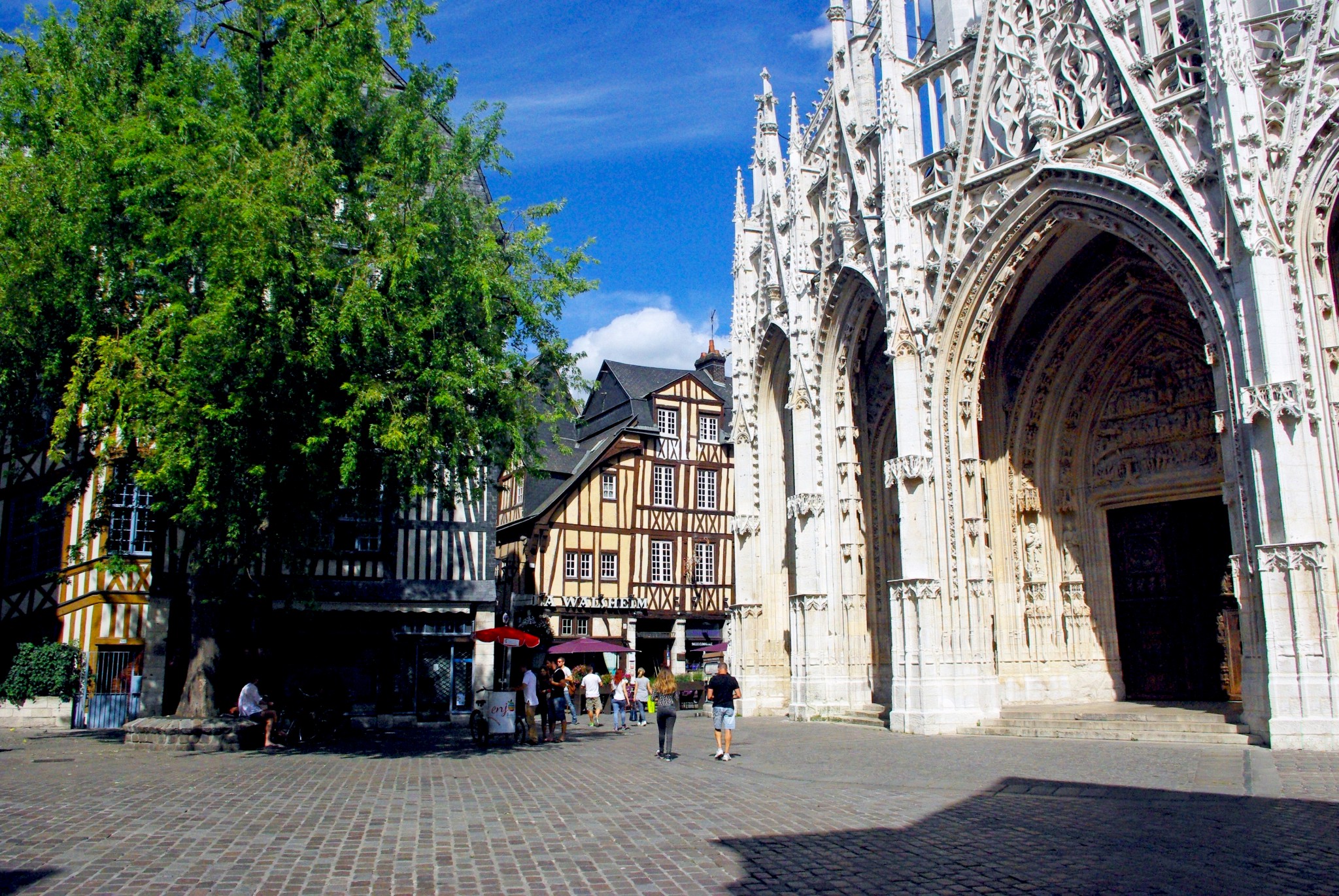
Take the rue de Martainville on the right when you exit the church. A few metres beyond the chevet of the church, enter the Aître Saint Maclou on your left.
The rue Martainville is one of my favourite streets when walking in the old town of Rouen. I love its typical half-timbered houses.
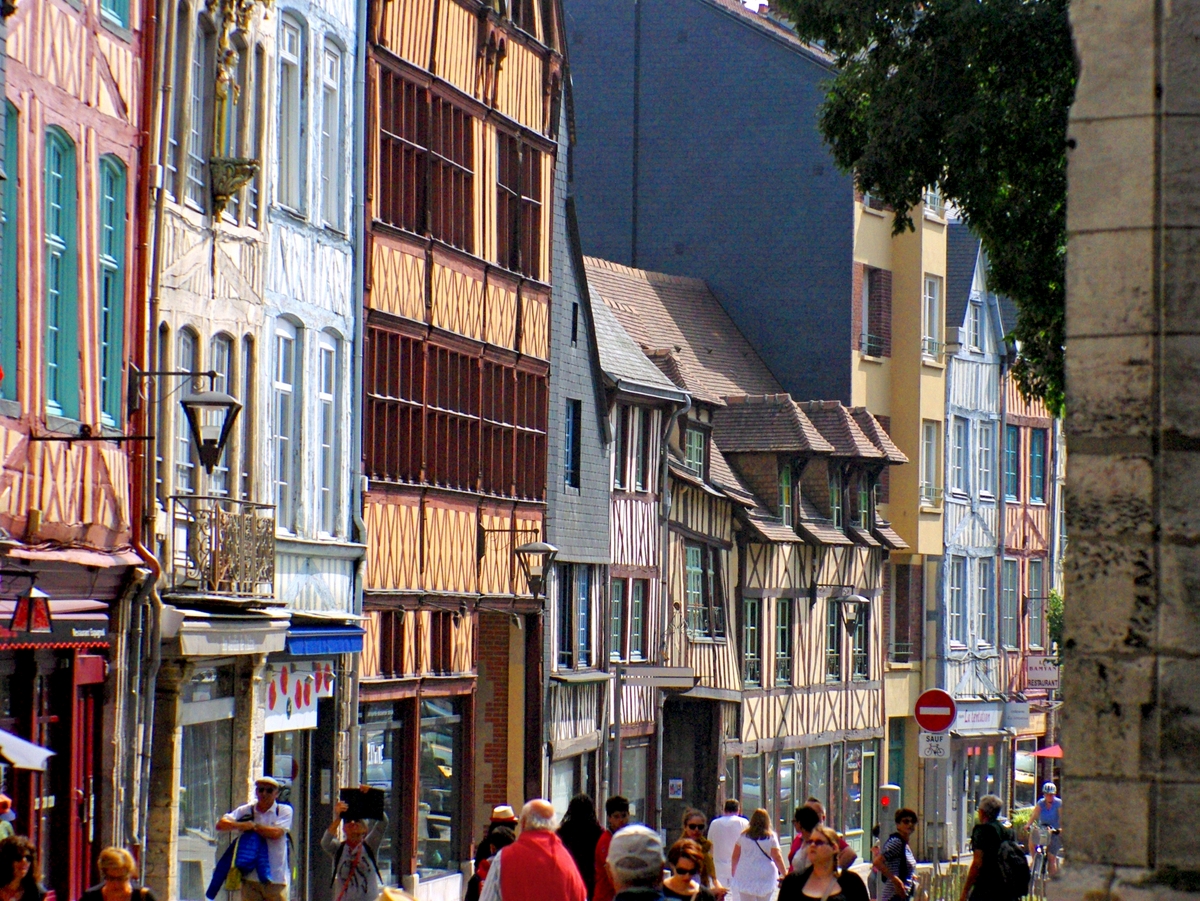
The Saint Maclou Ossuary
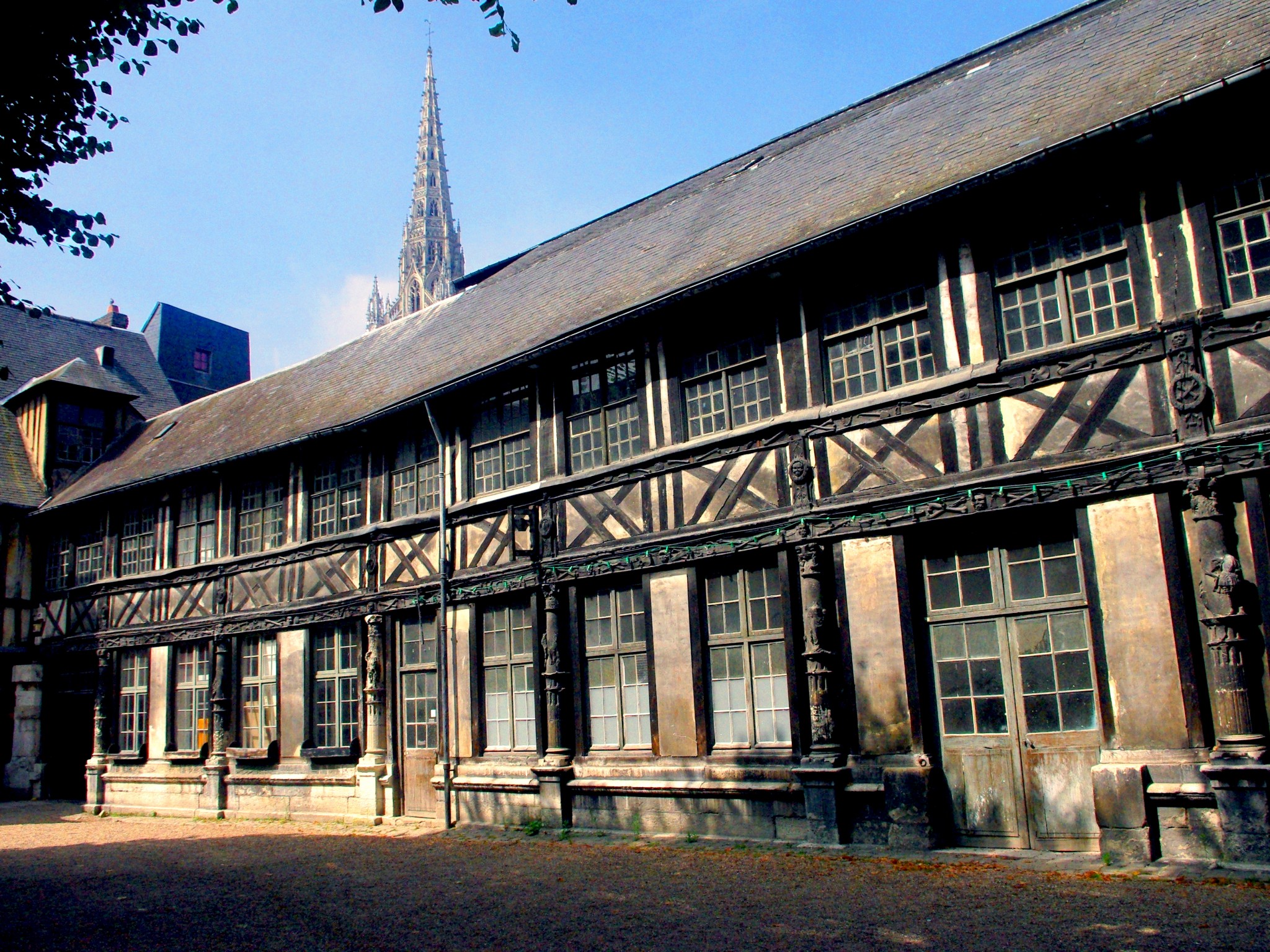
This is definitely one of the strangest sites of Rouen. The unique ossuary Saint Maclou (in French: Aître de St Maclou) is a popular landmark to discover. To place the ossuary in context, one must recall the Great Plague of 1348. As in most European cities, many of the townsfolk died during the plague. The cemetery around Saint Maclou became too small to house all the dead and a new cemetery needed to be built. Therefore, victims of the plague were buried on this site in large communal graves.
The decorations reflect their original purpose: skulls, crossbones, gravediggers’ tools and objects… Take a closer look on the columns and you will observe Death leading Life in a “danse macabre”.
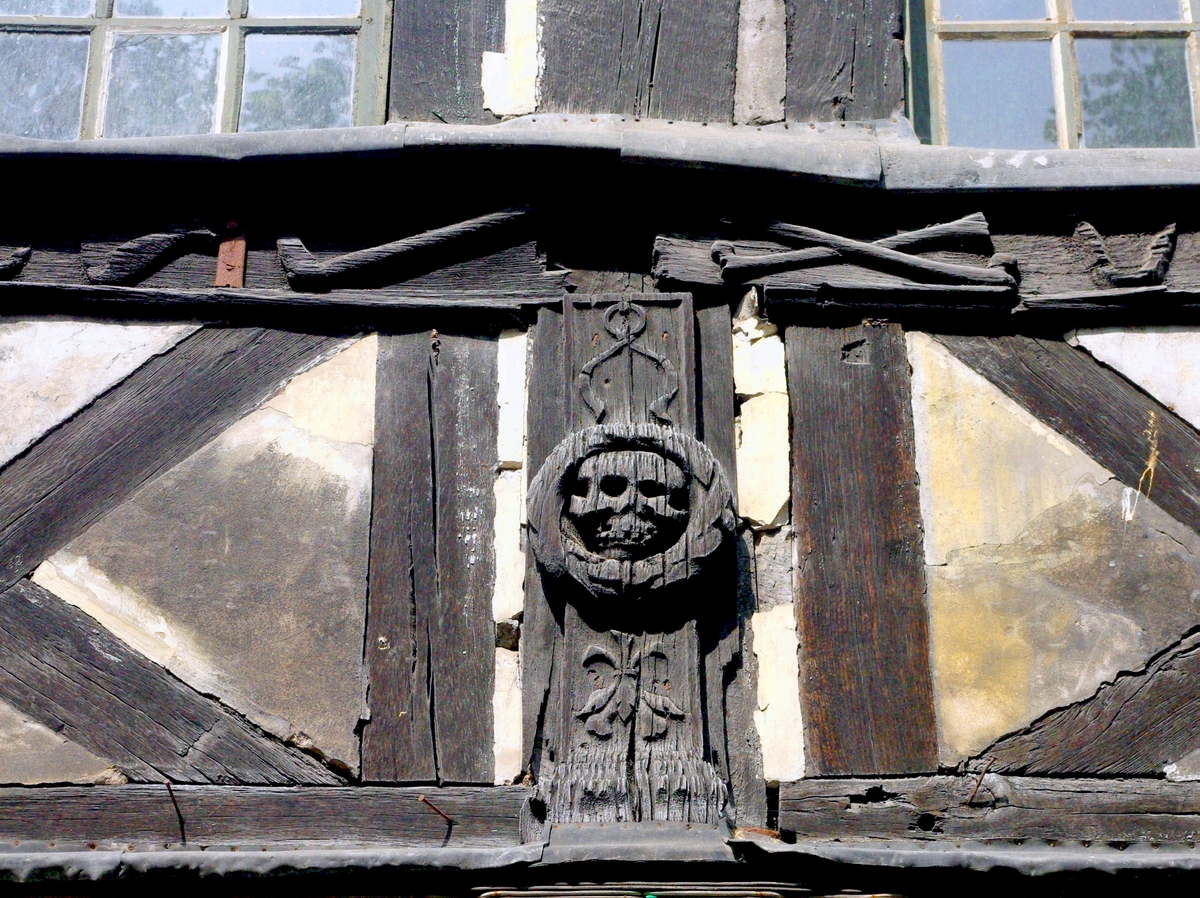
From the Aître Saint Maclou, return to Place Barthélémy and turn right on Rue Damiette.
Rue Damiette
Rue Damiette links the squares of Place Barthélémy to Place du Lieutenant Aubert. Restored half-timbered houses border the narrow street. On rue Damiette, the spire of Saint-Maclou seems to respond to the lantern tower of St. Ouen church.
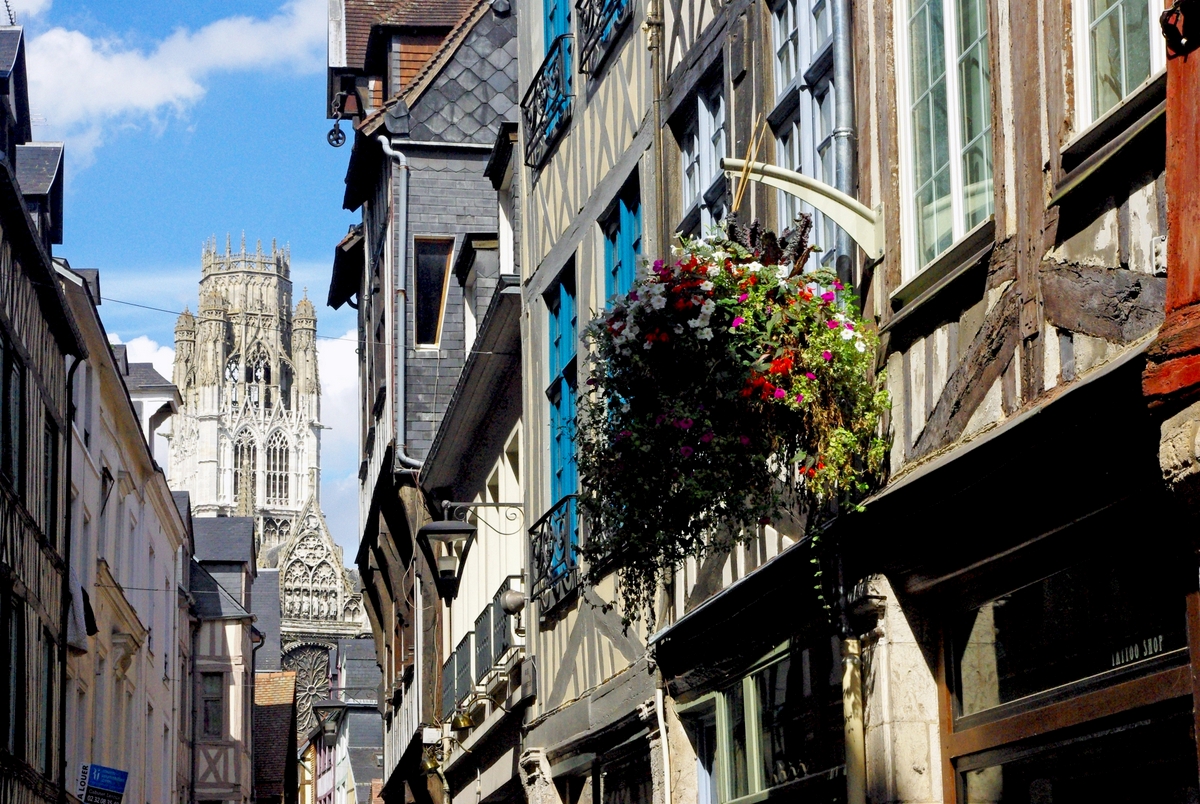
Cross the Rue d’Amiens and walk straight ahead for a few meters. On your left starts the medieval and picturesque Rue Eau de Robec.
Rue Eau-de-Robec
Rue Eau-de-Robec is lined up with half-timbered houses and in its centre is a streamlet crossed by a walkway.
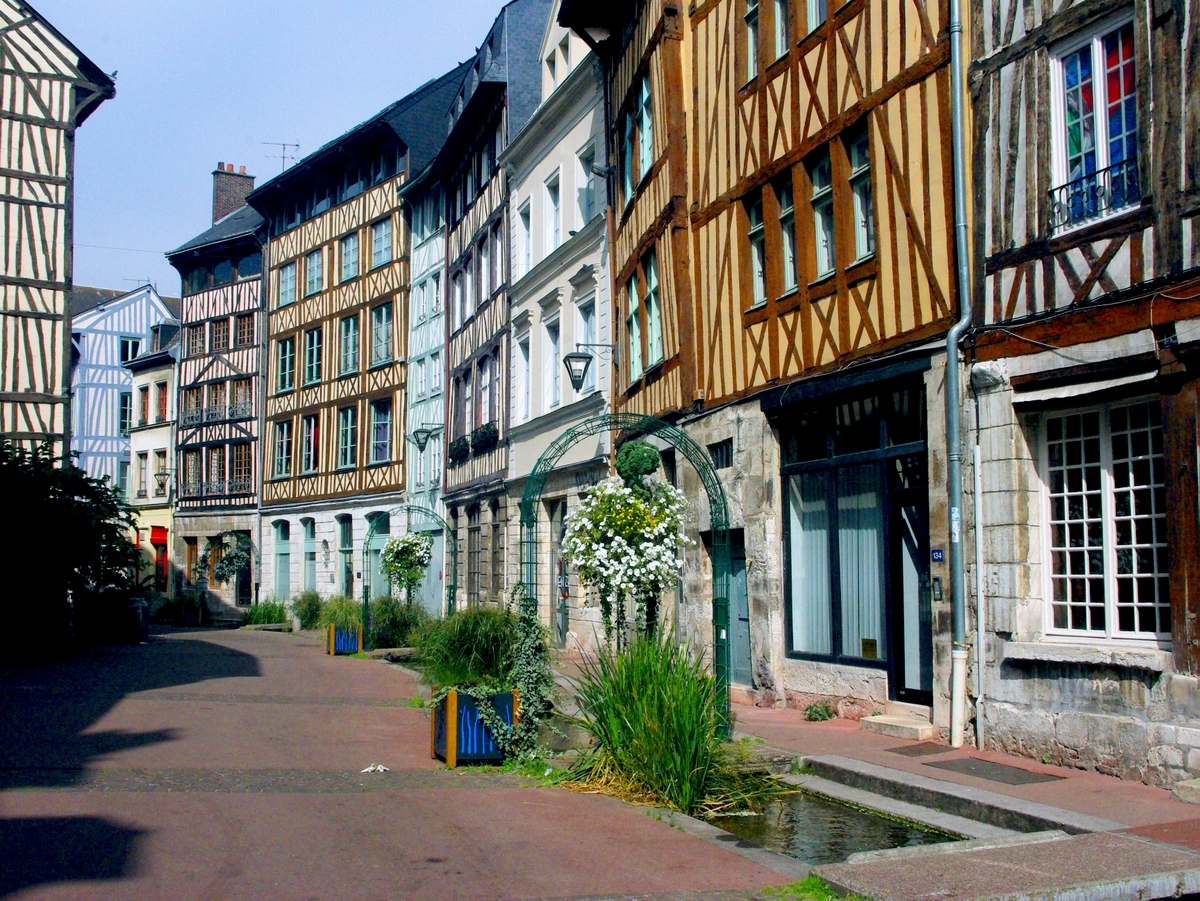
Arriving on the Place du Général de Gaulle, you will see the mighty Saint Ouen Abbey overlooking the greenery of the well-maintained gardens of the Town Hall. On your right, Rue des Faulx, stands an interesting row of half-timbered houses with the spire of Rouen Cathedral in the distance.
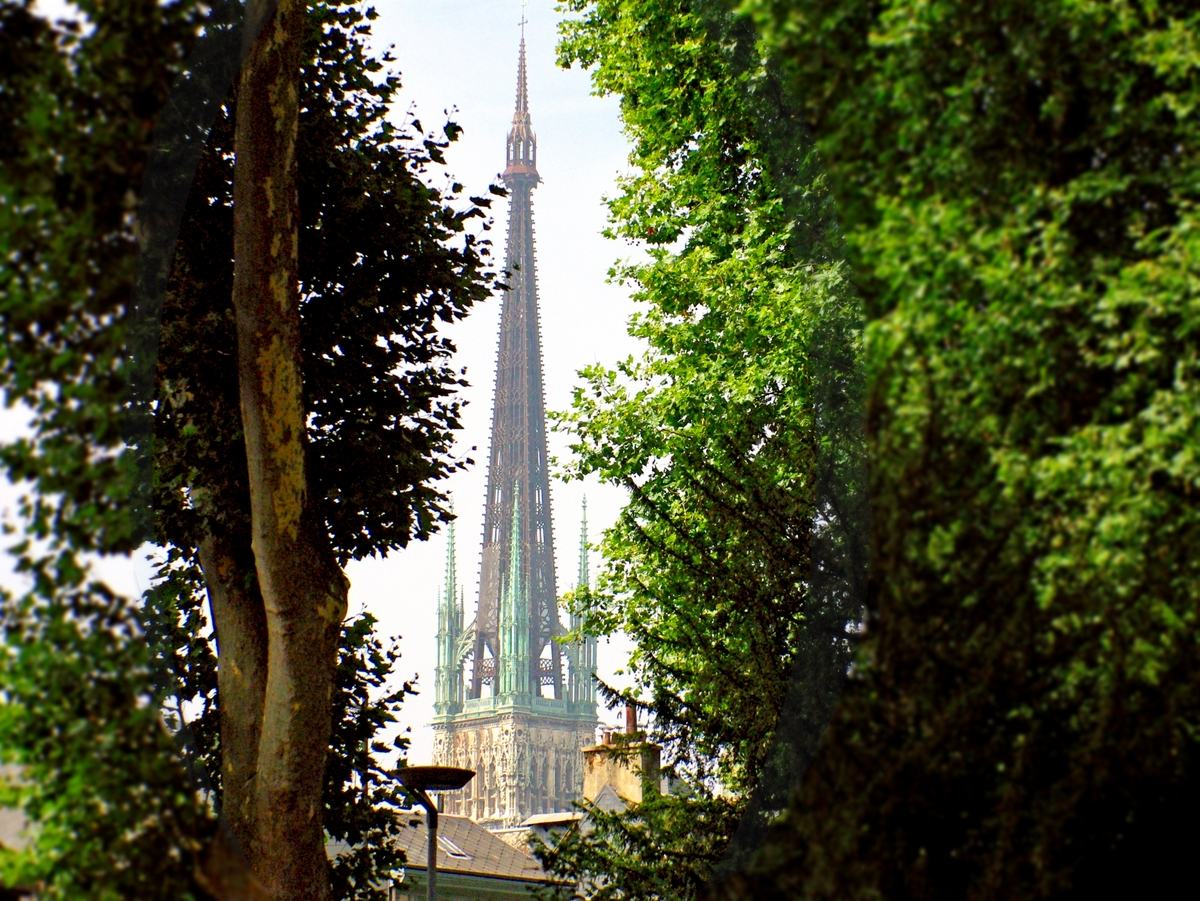
Enter the public park of the Jardins de l’Hôtel de Ville.
Saint Ouen Abbey Church
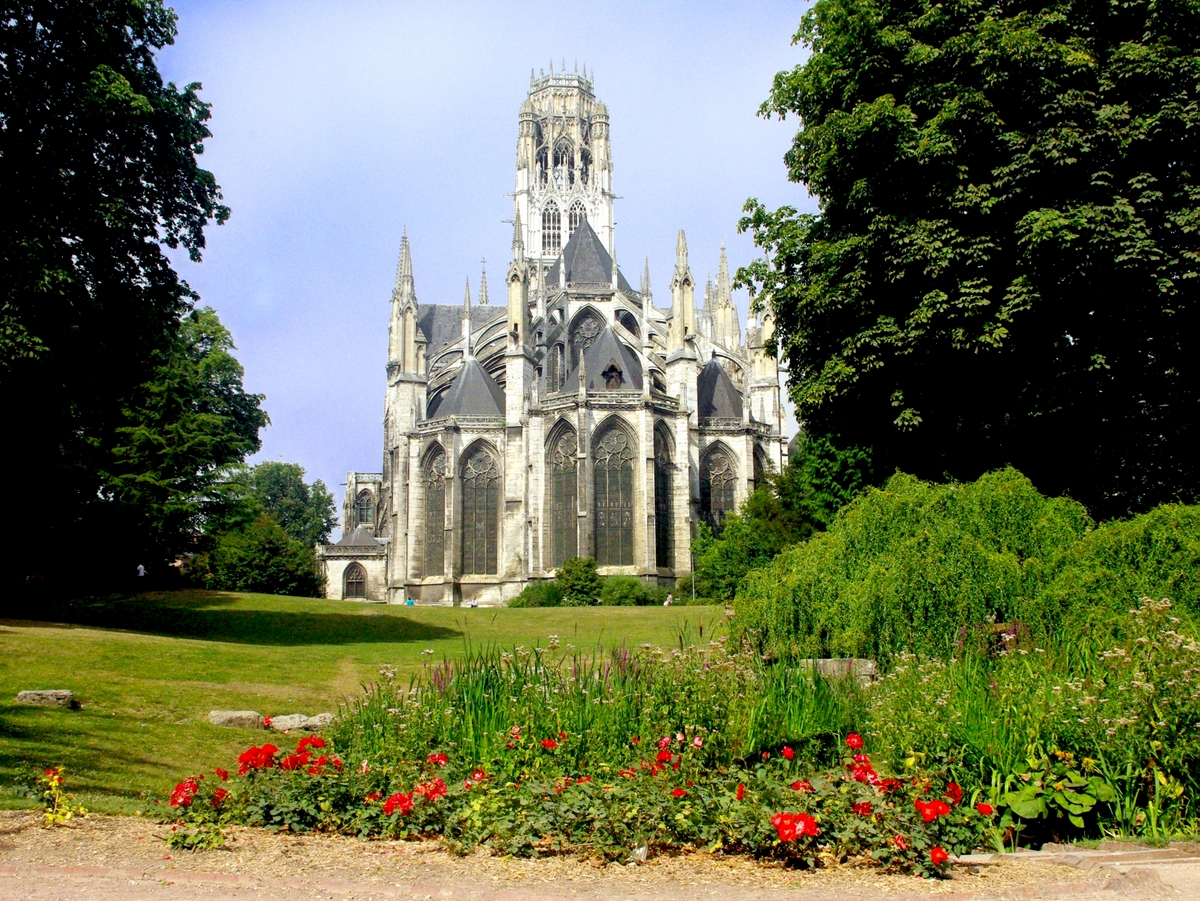
Saint Ouen is an impressive sanctuary and one of the largest churches built in the Rayonnant Gothic style. The abbey church comprises of two spire-towers on the western façade and a majestic 88 metre central tower. The latter rises above the crossing of the transept and is nicknamed the “Crown of Normandy”.
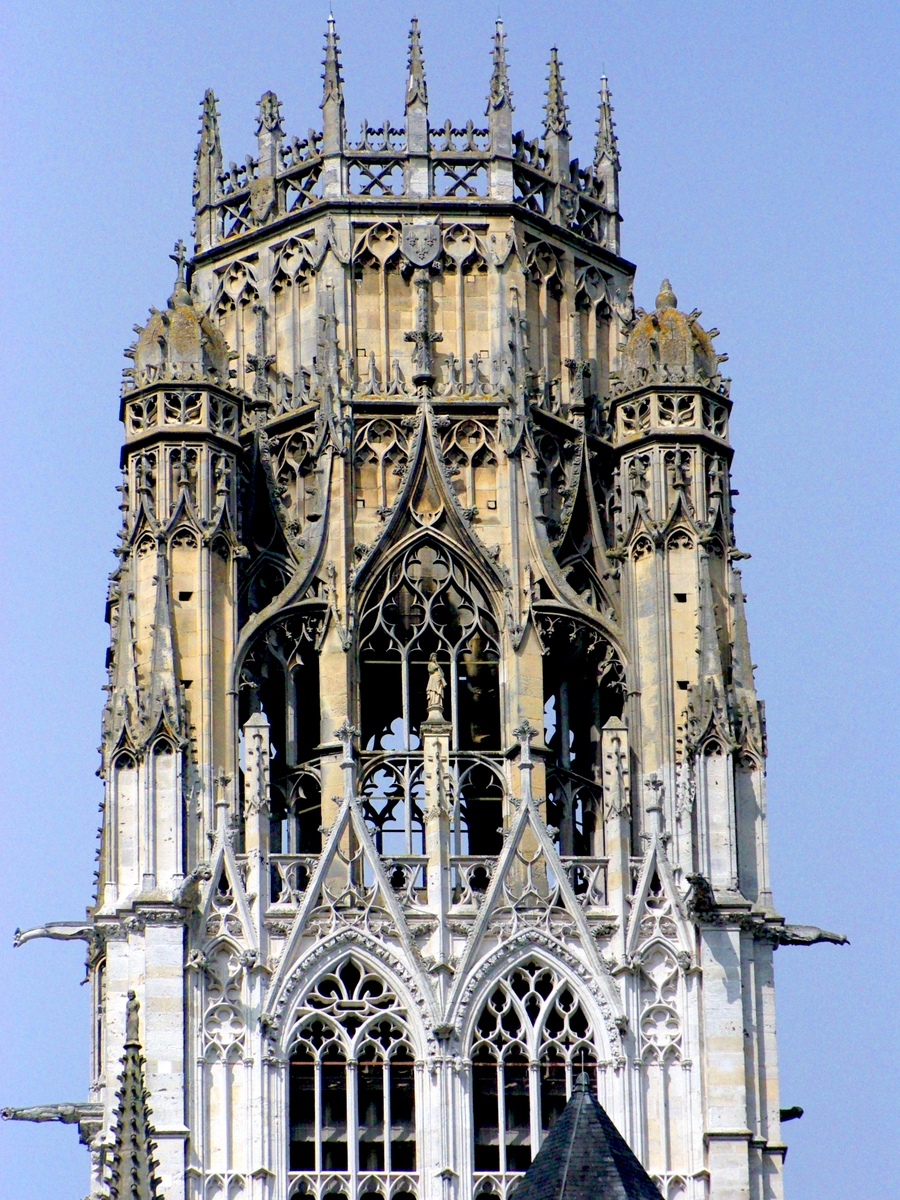
Take the time to stroll in the Gardens of the Town Hall which surround the Abbey with have views of the whole building. To the North stands the classical building of Rouen’s Town Hall.
The City-Hall of Rouen
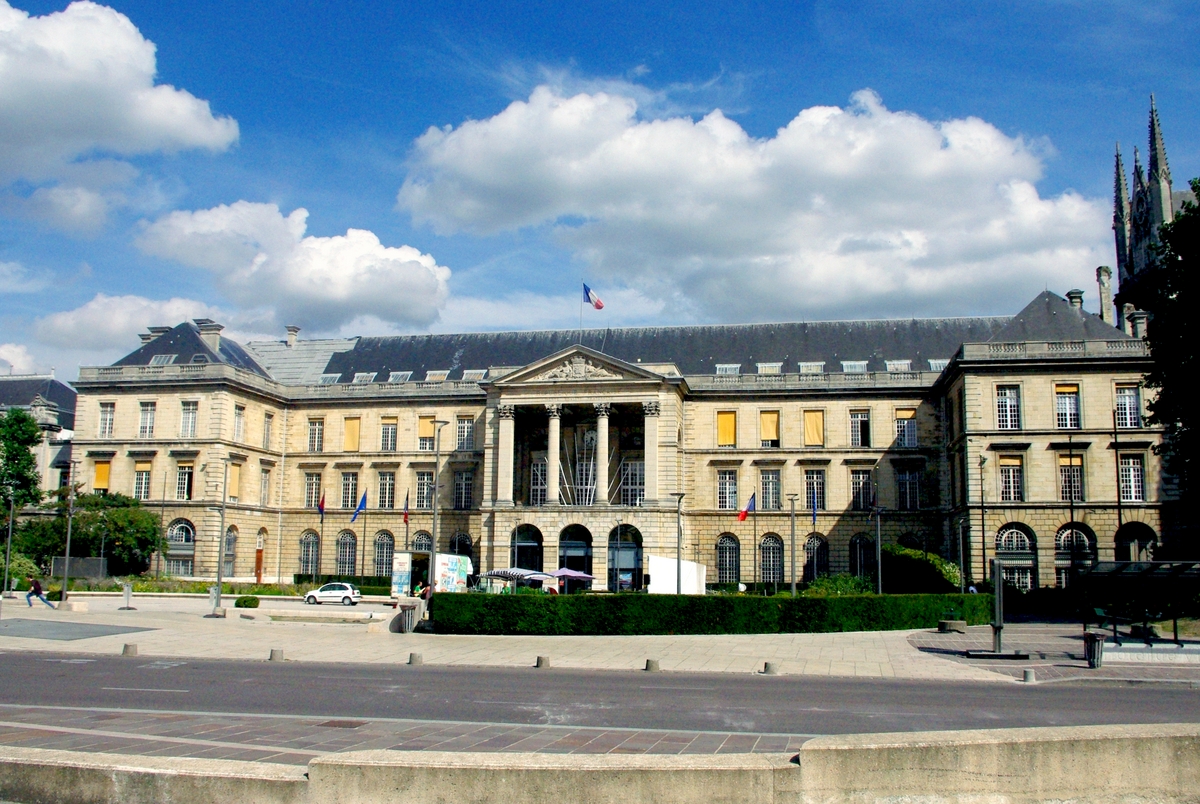
The classical building which stands close to the Abbey is Rouen’s present day City Hall. It was the monk’s dormitory until the French Revolution. The monks had only just completed the building when they had to give it away to the municipality.
Reach the narrow and picturesque street of rue du petit porche and at the end of the street turn left to the Place de la Rougemare.
Place de la Rougemare lies outside the limits of the touristy part of Rouen but is worth mentioning for its peaceful character.

Continue on rue du Cordier and cross the Place du Dr A. Cerné to reach the rue du Donjon.
Rouen’s Tower of Joan of Arc
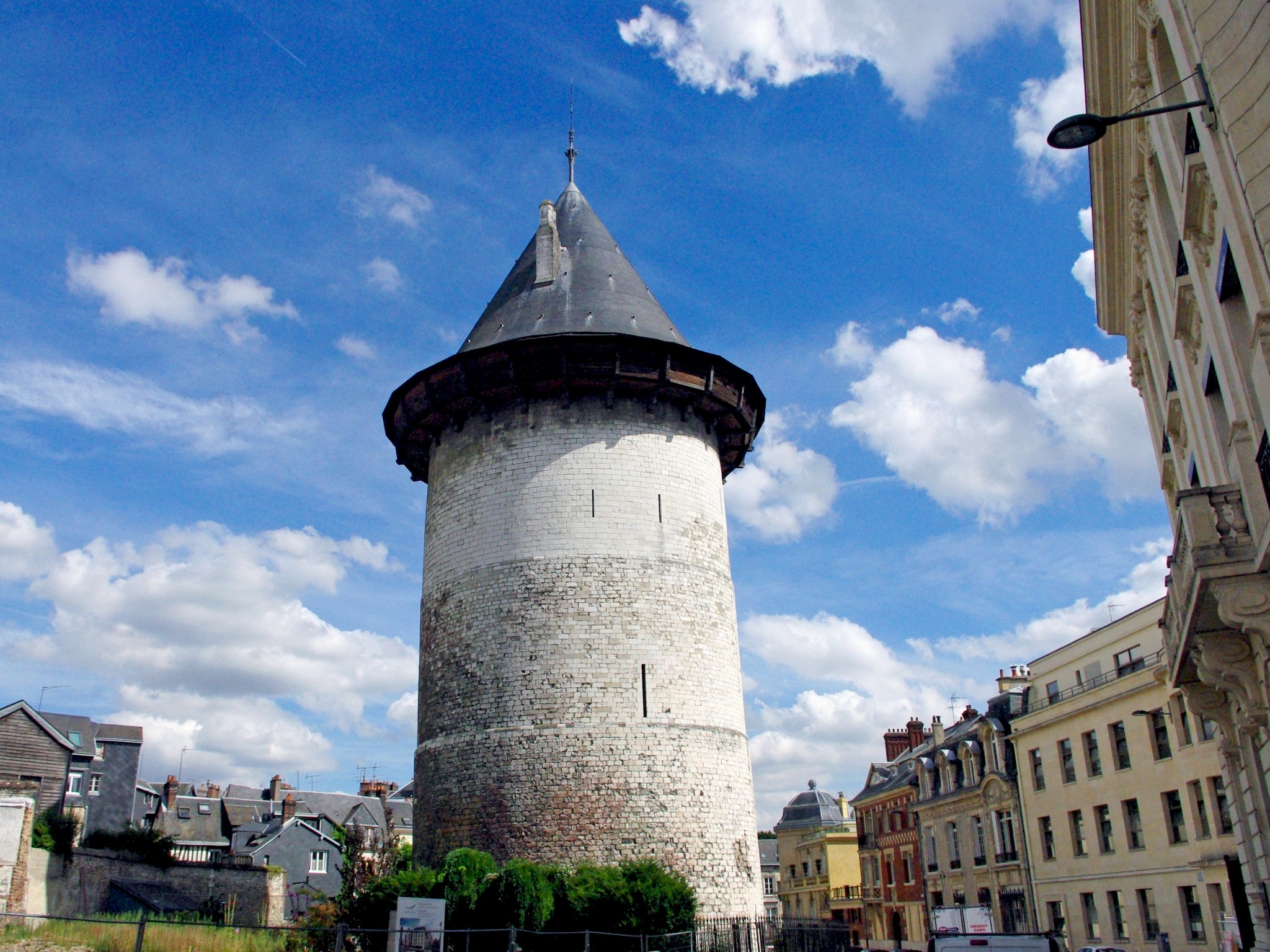
Oddly overlooking a residential area, the medieval tower is all that is left of the once-mighty castle of Rouen. The king of France order its dismantlement in the 16th century. However only the keep still stands to this day. It bears the name of Joan of Arc Tower since the maid entered the castle prior to her imprisonment by the English.
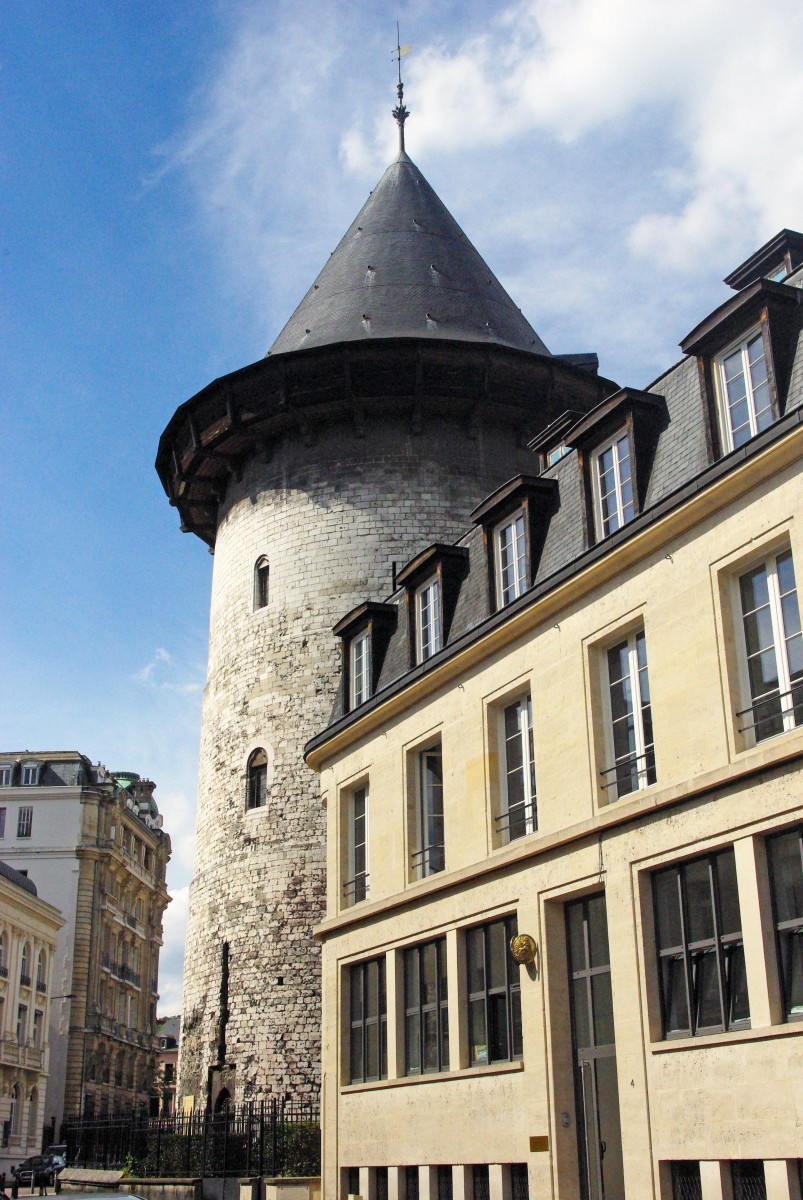
Return to the crossroads and turn right to rue Bouvreuil to the Fine Arts Museum of Rouen.
Square Verdrel and the Fine Arts Museum of Rouen
The public garden of the Square Verdrel opened in the Second Empire (mid-19th century). It faces the massive building of Rouen’s Fine Arts Museum.
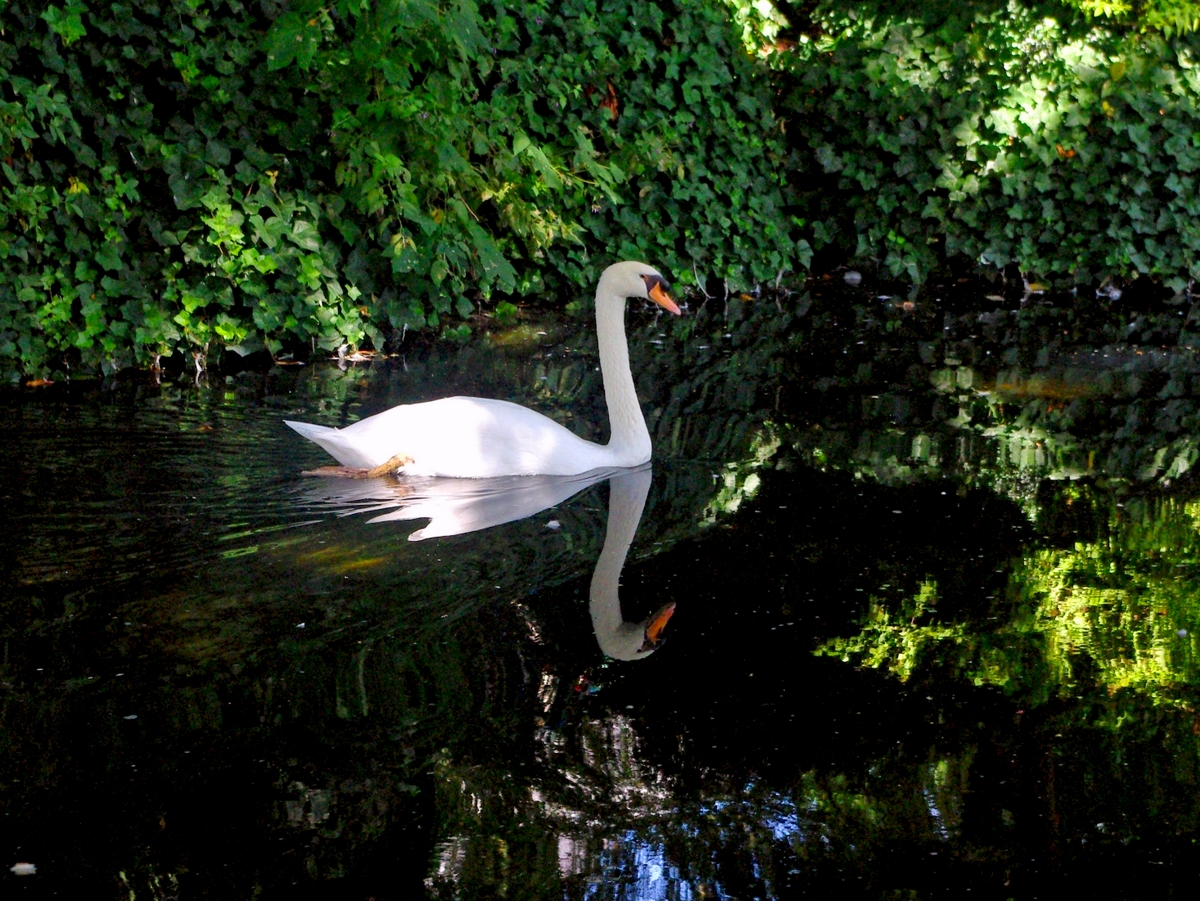
It was Napoleon I was founded the renowned museum. However the present building only dates back to the end of the 19th century. It underwent restauration works in 1994.
Cross the rue Lecanuet and walk through the rue de l’écureuil where you can stop for a good cup of coffee at Citizen Café.
Turn left on the rue Ganterie.
Around the Place des Carmes
The rue de Ganterie is lined up with some interesting half-timbered houses.
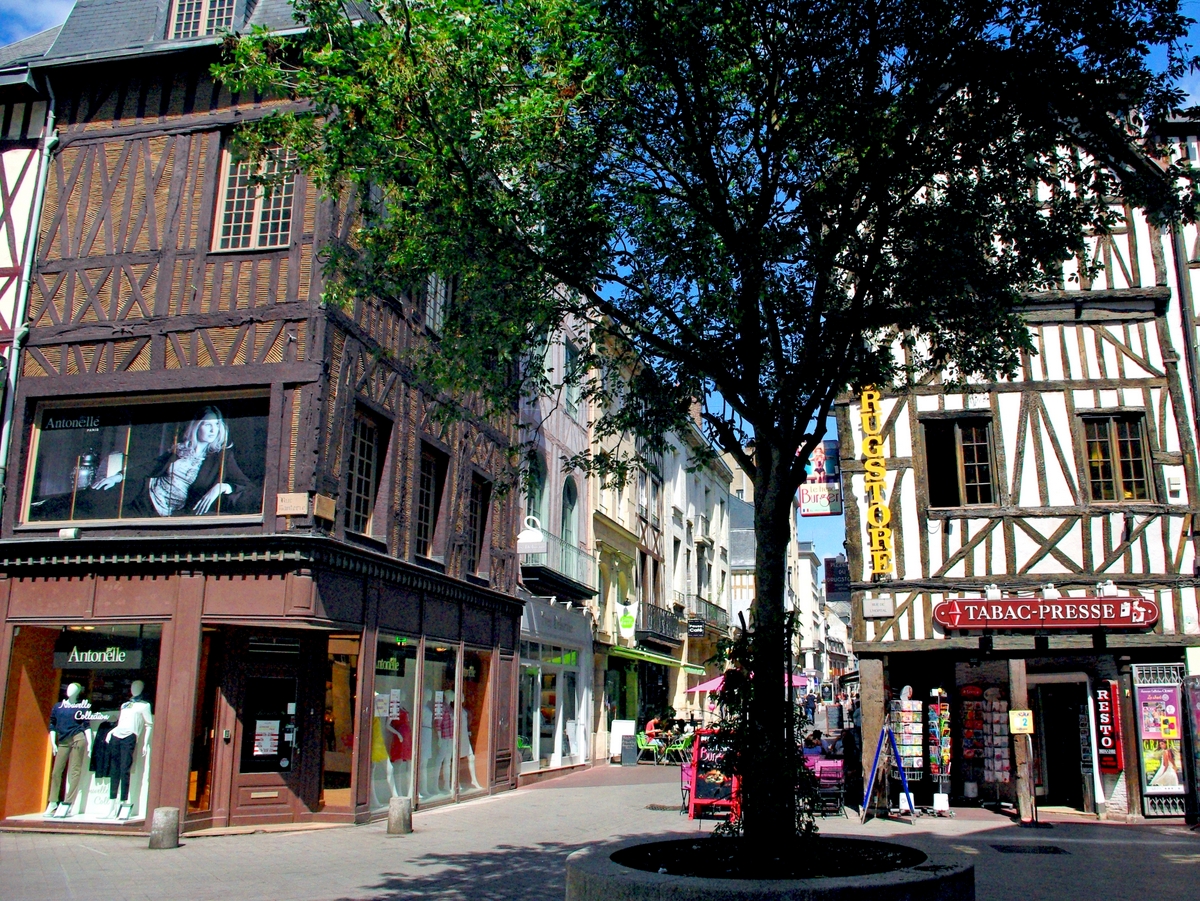
Turn right on the rue des Carmes and reach the Place des Carmes. From there, take the rue de la Chaîne which is bordered by a fine half-timbered hôtel particulier.
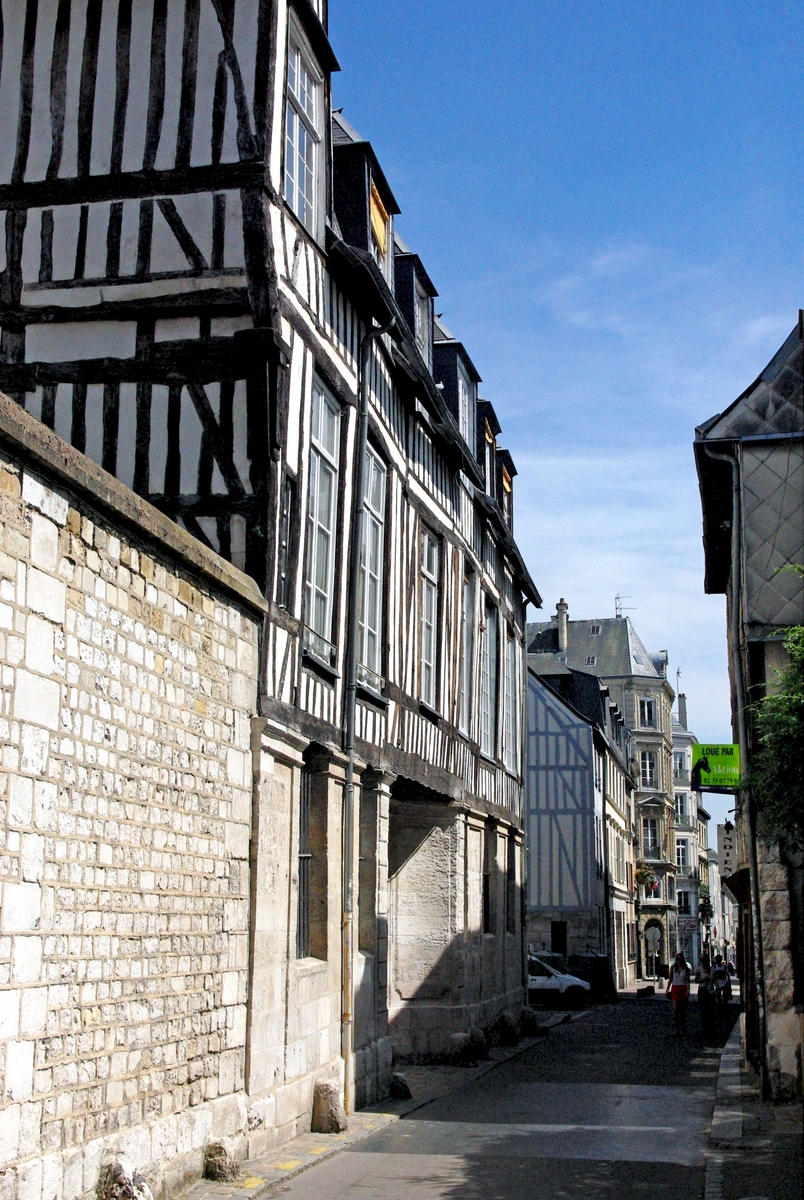
At the end of the street is the Place Saint Amand.
Café terraces occupy the little Place Saint-Amand in the Summer. There are some beautiful half-timbered houses to admire.
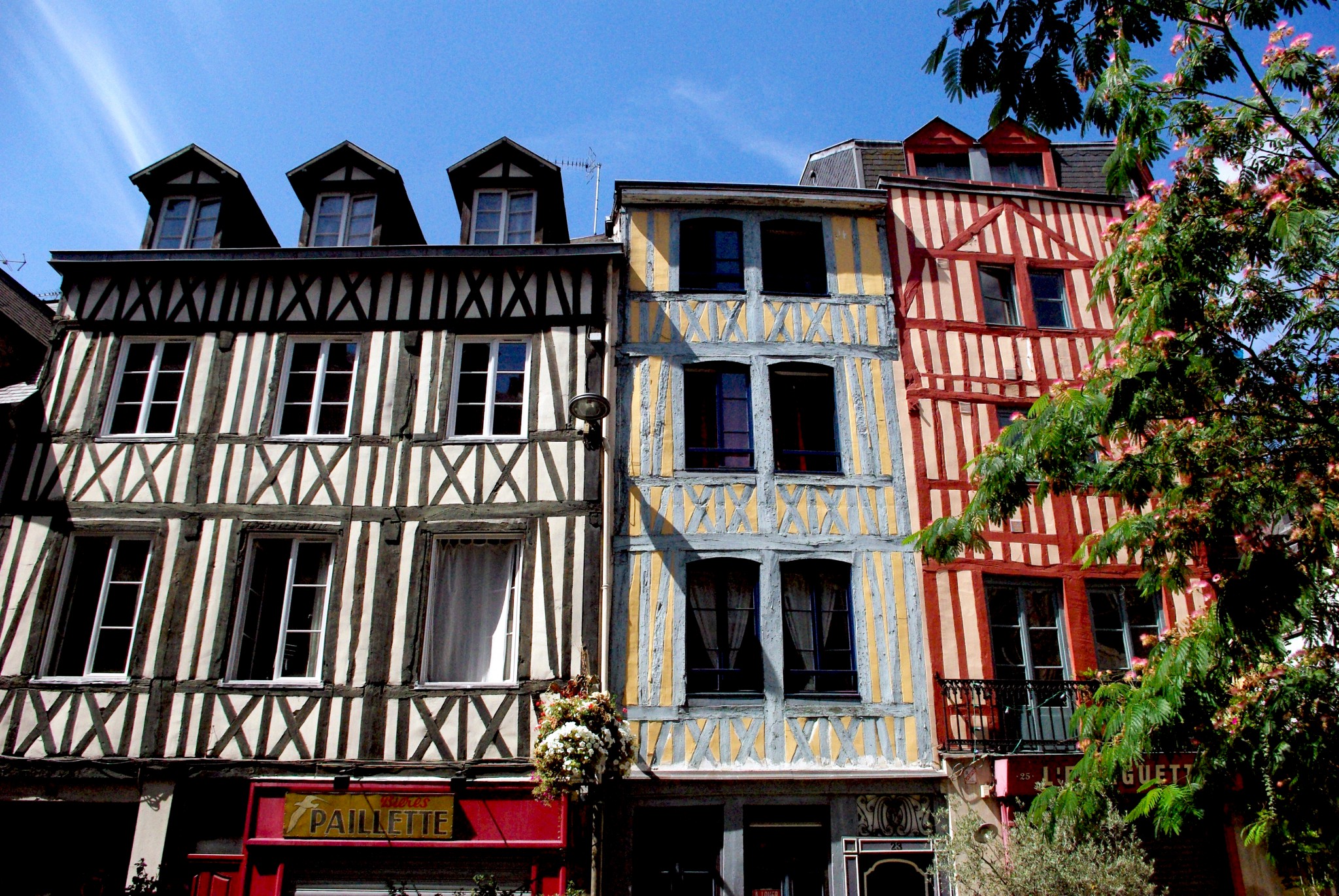
Follow the narrow street of rue Saint-Amand.
Another picturesque place I discovered while walking in the old town of Rouen – Rue Saint-Amand really gives an idea of what Rouen looked like in the Middle-Ages:
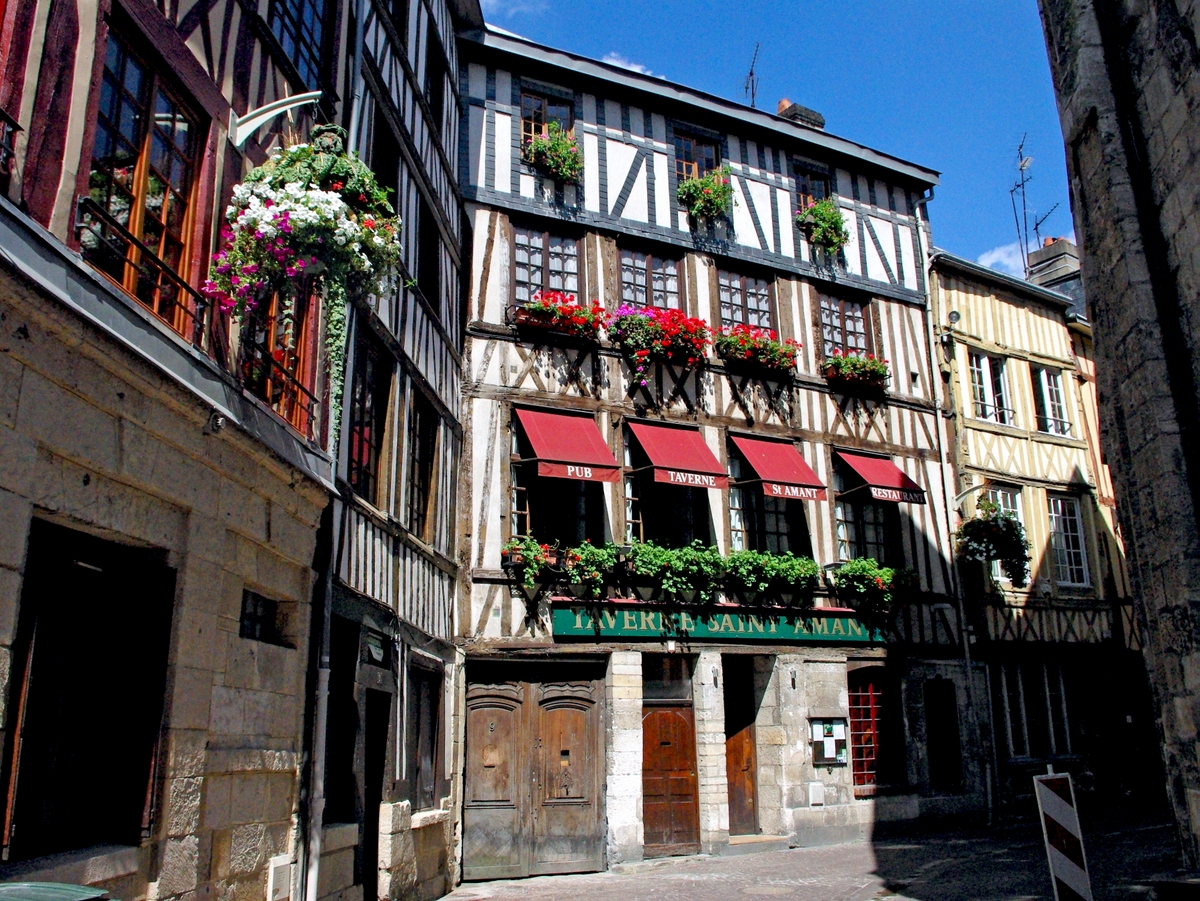
Reach the Place de la Cathédrale by walking through the rue Saint Nicolas and rue de la Croix de Fer.
From the Cathedral square, take the rue des Carmes on the right and turn left on the rue aux Juifs.
The Parliament of Normandy
Rouen may be famous for its Gothic churches, however these should not over-shadow other civil buildings. One of them is the Gothic building of the Parliament of Normandy. One of the rare civil constructions in Gothic style in the late Middle Ages in France.
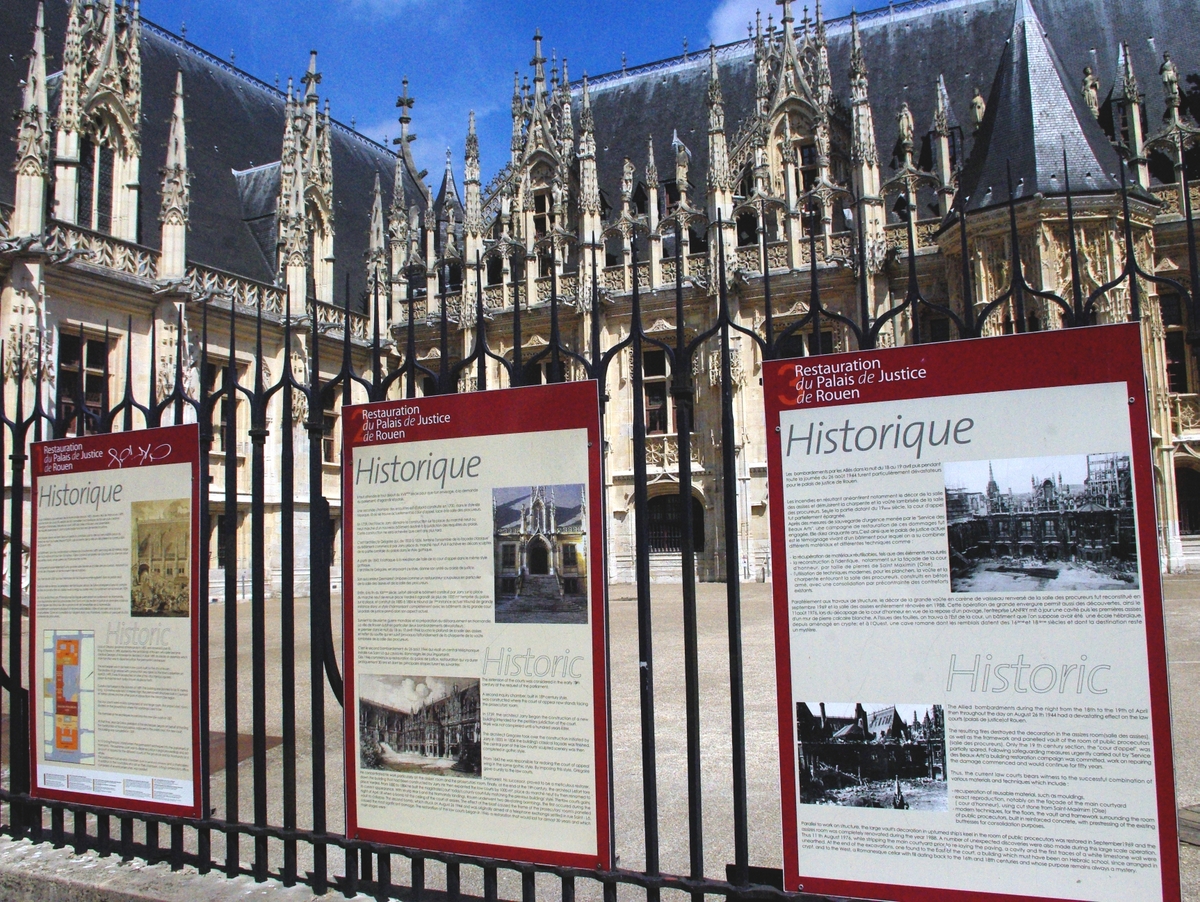
Once the Gothic building was the seat of the Parliament of Normandy. The remarkable edifice features typical Gothic decoration: crocheted pinnacles, gargoyles, four centred arches, statues and a Flamboyant balustrade with interlaced rosettes at the base of the roof.
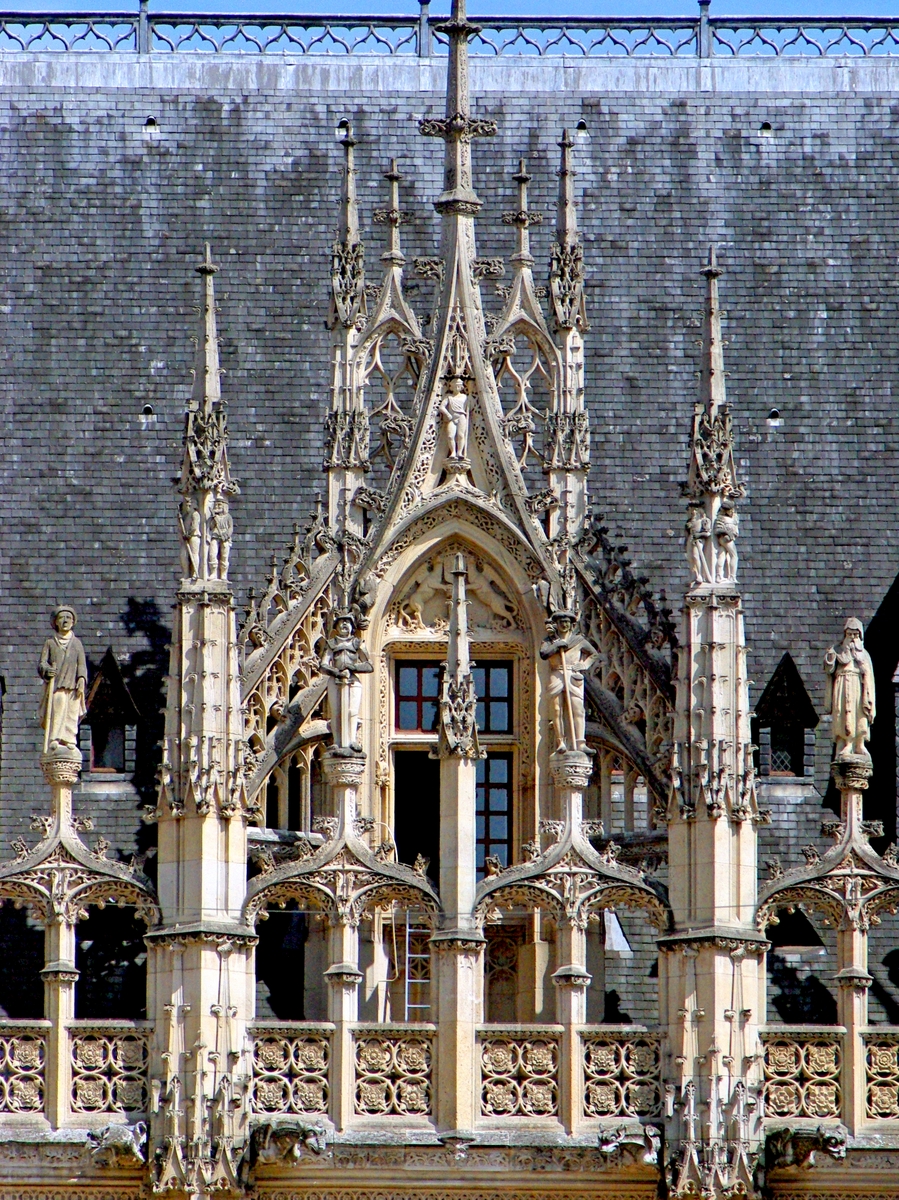
When reaching the end of the building on the rue aux Juifs, turn right on the rue Jeanne d’Arc before taking the rue Guillaume le Conquérant to the left. Walk along the street until you reach the rue Écuyère. Take the street on the right and walk to the next crossroads with rue des Bons Enfants.
Rue des Bons Enfants
Continuing the axis of rue Ganterie previous crossed is Rue des Bons Enfants. Fine half-timbered houses border the street. Observe them closely: one of them seems it will collapse at any time soon!
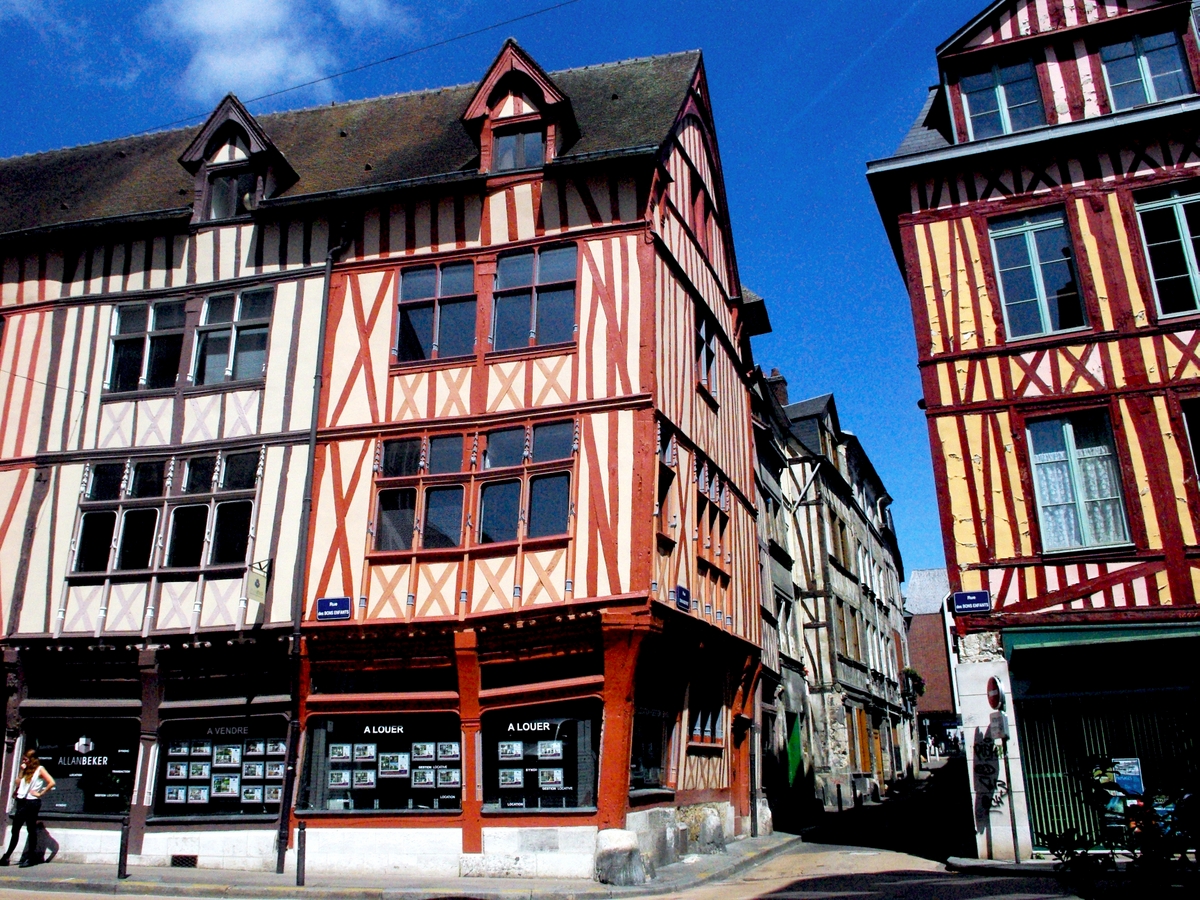
Walk along the rue des Bons Enfants and turn left on the rue de l’Ancienne Prison to reach the last stage of our walk: the Place du Vieux-Marché.
Place du Vieux-Marché
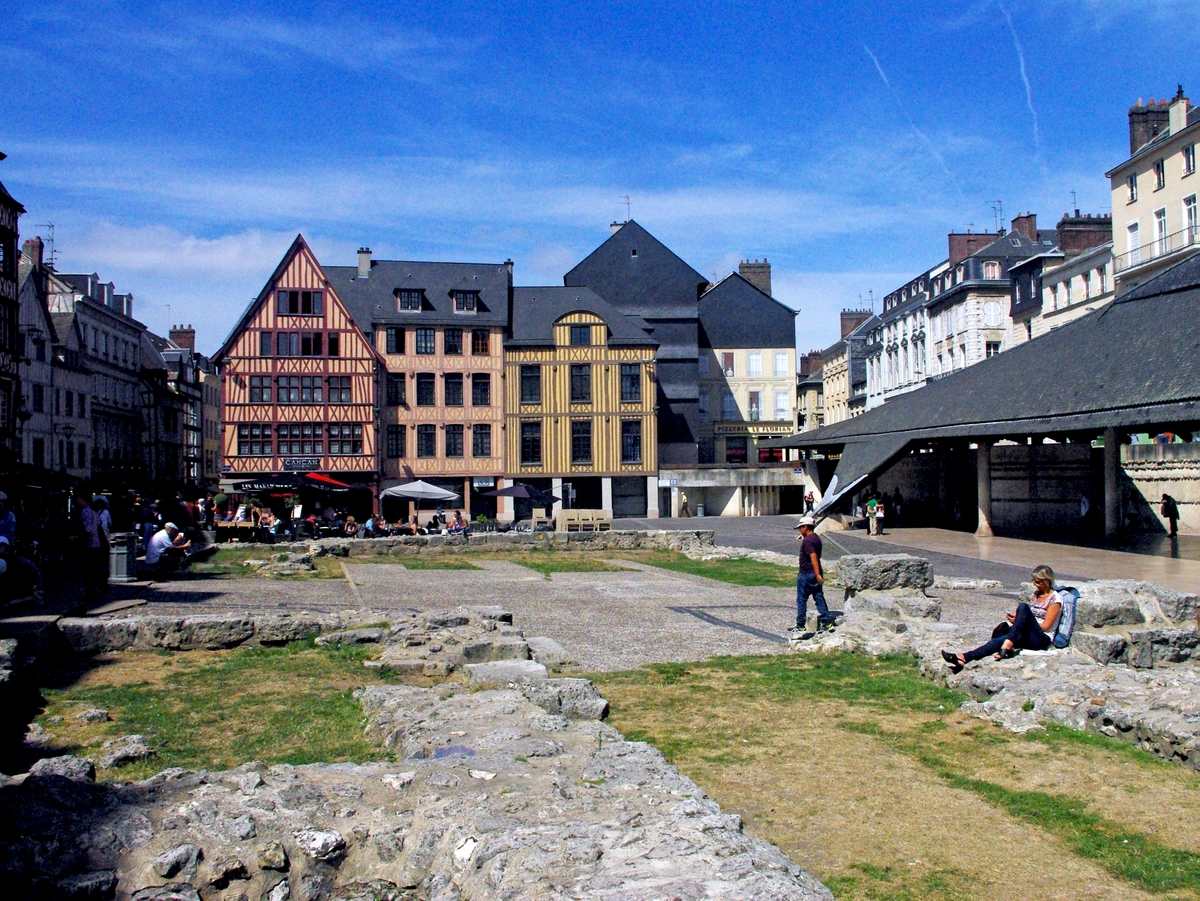
Place du Vieux Marché is arguably the main square of Rouen’s old town. With its half-timbered houses and restaurant, it is dominated by the modern church of Saint Joan of Arc.
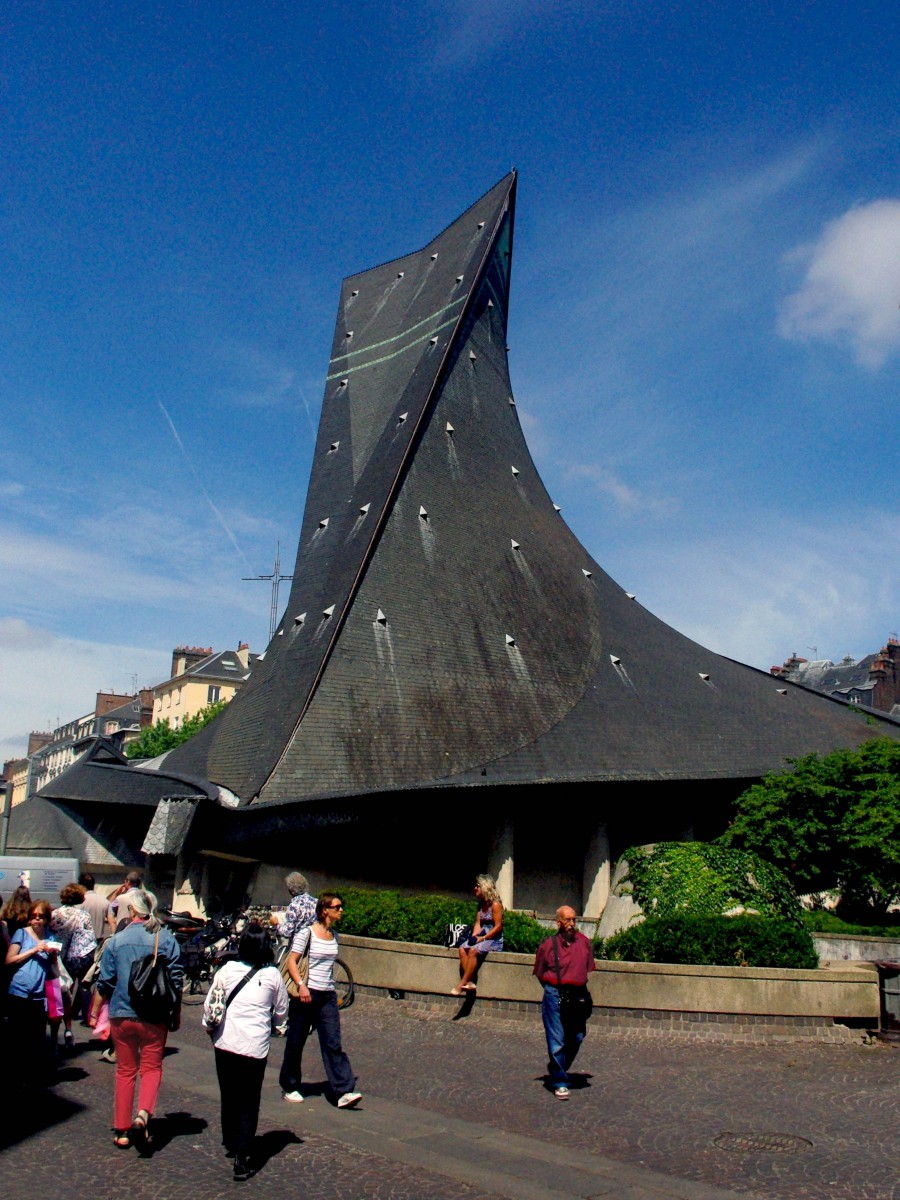
The 1979 modern and wacky and spiky-looking memorial church is at odds with the surrounding fine brown-and-white half timbered houses. Some people see in the shape of the church an upturned boat or the pyre on which the Saint was burnt. The church is surmounted by a trapezoidal slate roof topped the church. The elongated feature forms a walkway across the square. In addition the scaly tiling of the roof matches the fish-shaped windows.
Inside the church
Inside, 13 stained-glass windows from the Renaissance era form a glass wall of 500 square metres. It bathes the interior in exceptional light.

These fine windows date back to the 16th century. They originally decorated another church which was destroyed during the Second World War. However, authorities anticipated war damages and put the windows in safe. They stored them untouched until they found their new home some 40 years later.
The stained-glass windows illustrate Christ’s childhood, Passion, Crucifixion and Resurrection, and life events of Saint Peter, Saint Anne and Saint Anthony of Padua.
Where was Joan of Arc burnt at stake?
A small commemorative plaque and a 20 metre high cross mark the spot on which Joan of Arc was burnt alive on the 30th May 1431. On the adjacent walls, the marks of a former church destroyed in the past are visible.
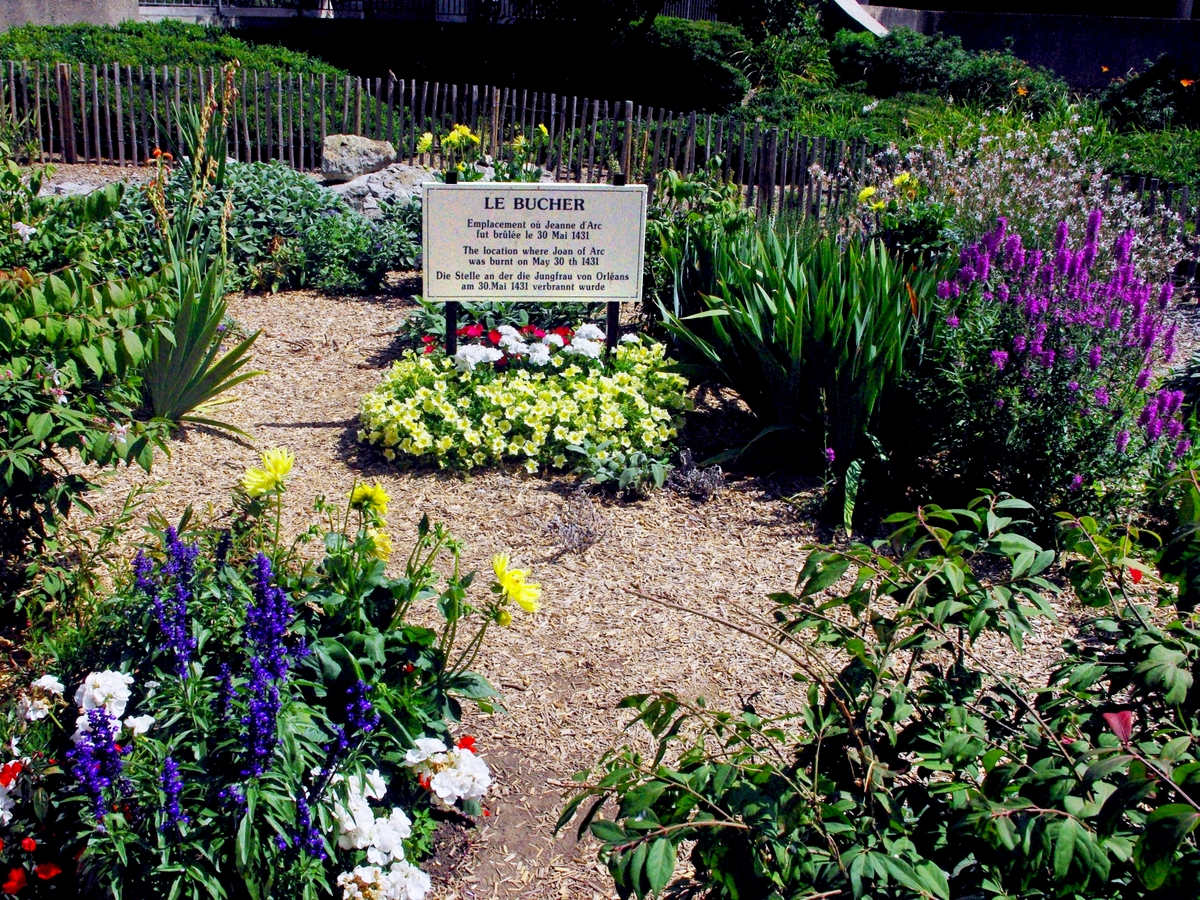
This walk ends at the Place du Vieux-Marché. For another interesting walk in Rouen why not ascending the Côte Sainte-Catherine for a panoramic view of the whole city of Rouen…
Things to do in Rouen, Normandy
Looking for activities and things to do in Rouen? Check out the offers from our partner Get Your Guide:
Walking in the old town of Rouen: more info
Here’s a few website and blogs about Rouen that you might find useful:
- on the blog: Rouen Old Town
- on the blog: Rouen Cathedral
- Tourist Board of Rouen
- Tourist Board of Normandy
- Wikipedia’s article on Rouen
Inspired by walking in the old town of Rouen? Pin it for later!

Some of the links above are affiliates so if you’re planning a trip, using these links helps me keep things running. There’s no extra cost to you. All you have to do is click the link and any booking you make is automatically tracked.

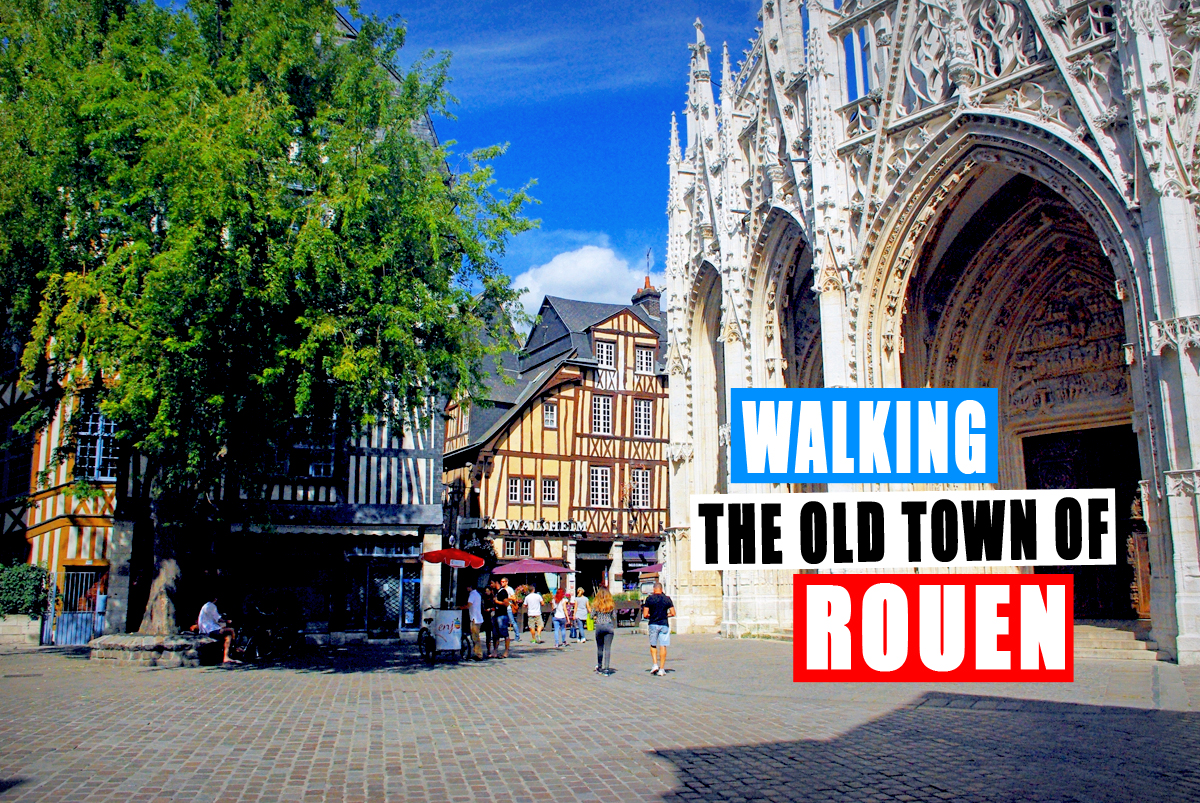


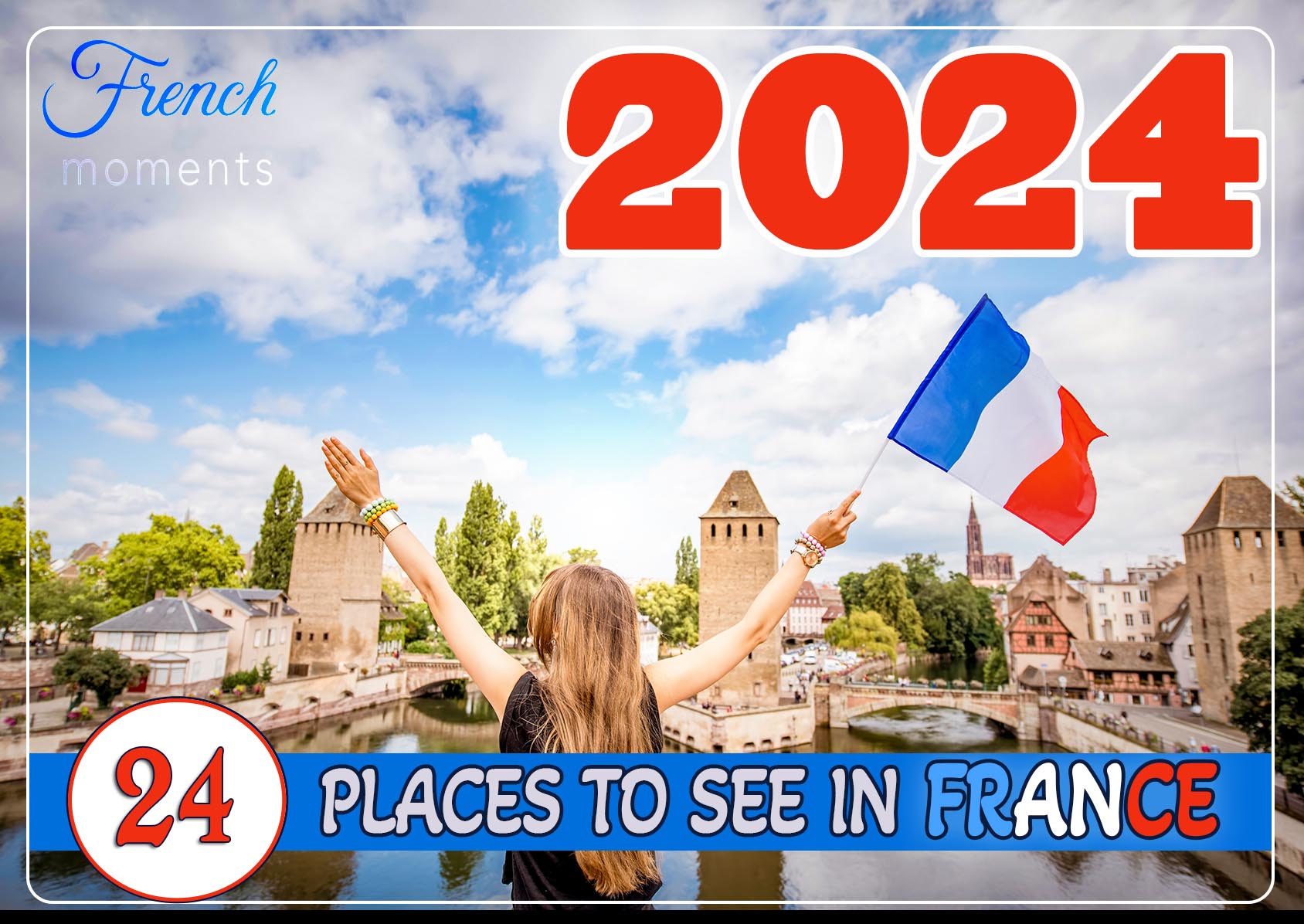
Pierre, I like your instructions and map. I will be doing Rouen in a day trip. I wonder if you can recall how long this walk took? Thanks!
Hello Karen, actually it took me a full day but I did stop at many sites to take photos. Realistically I would say half a day is enough to discover the old town of Rouen (without entering the museums).
Hello, thank you for your response to my question! It’s good to know I can do your path in less than a full day. I’ll re-work the order in which I follow your course, as I’d be starting from the train station. That should work well if I can re-order all the sights, and then I can finish with the museum. I think your online walking tour and commentary is very nice, helpful, and well done!
Best,
Karen
Thank you Karen! I was hoping to update this page soon as it has been a little while since I published it (3 years ago). Enjoy Rouen! 🙂
Merci, Pierre. I will be in Paris and Rouen and Giverny at the end of April; if you edit or update any info on this page before that, would you let me know!
Best.
Karen
Merci, Pierre. This is my 4th attempt to reply to your last message; for some reason, they are not getting through. Anyway, I was saying I will be in Paris, Rouen and Giverny at the end of April, so if you edit or update any info on this page, please let me know!
Best,
Karen
Hello Karen! Yes, this reply got through!! 🙂
I will let you know when the article is updates, I’ll try my best before your trip 😉
Cheers,
Pierre
Dear Pierre,
I am a Kiwi but have lived in England since 1959. Fitted in 5 years in Sydney and 5 years in Mayenne. My daughte has lived in the Deux Sevres for over 20 years and I am a Huguenot descendant. I enjoyed the virtual walk around Rouen which I have managed to bypass for years but never enjoyed.
I am a researcher at the Huguenot Museum Archives in Rochester and work on possible Huguenot inquiries.
I am researching for my own interests a Jean Tirel, a Huguenot pastor who died in prison in Rouen in 1693.
In your own research on Rouen have you discovered any images of the Ancient Prison of the 1690s?
Edward Hill
Dear Edward,
Thank you for your comment. Unfortunately I didn’t stumble across images of the old prison. According to my research, this pastor from Chefresne et Gavray was imprisoned at the Conciergerie of Rouen’s Palais de Justice… if I’m not mistaken it would be the site of today’s Court of Justice, a beautiful flamboyant monument still standing in the old town.
Thanks for your trouble Pierre.
I thought the prison was different from the Palais de Justice as he
describes being allowd outside to exercise on the Ramparts. Aren’t the
address of the Court of Justice and Rue de Ancienne Prison different
locations?
I will make the effort on one of my next trips through Rouen to follow
your tour, as my daughter works in Niort.
Regards
Hi Edward. Well in fact rue de l’Ancienne prison was a street located next to the Palais de Justice (source : https://fr.wikipedia.org/wiki/Rue_de_l%27Ancienne-Prison) so good news it concurs to what your say! 🙂
Thanks again Pierre. Will concentrate on finding an image of the old Concegiere.
Regards
Edward Hill
Bonjour Pierre,
Thank you so much! Every photo is beautiful. You are so generous sharing your experiences as they happen. You don't wait until you get back home. That takes away sleep time!
Safe and wonderful travels!
Bob Rogers
Always a pleasure, merci beaucoup Bob! 🙂